It’s Mardi Gras Week, and I am spending time at the homestead, my future place of exile, in the rice-sugar transition zone around Bayou Vermilion.
It’s Ash Thursday, 7 March 2019, three days after my photo-filled Lundi Gras trip here, and the lately-once-weekly Abbeville Branch train is running!
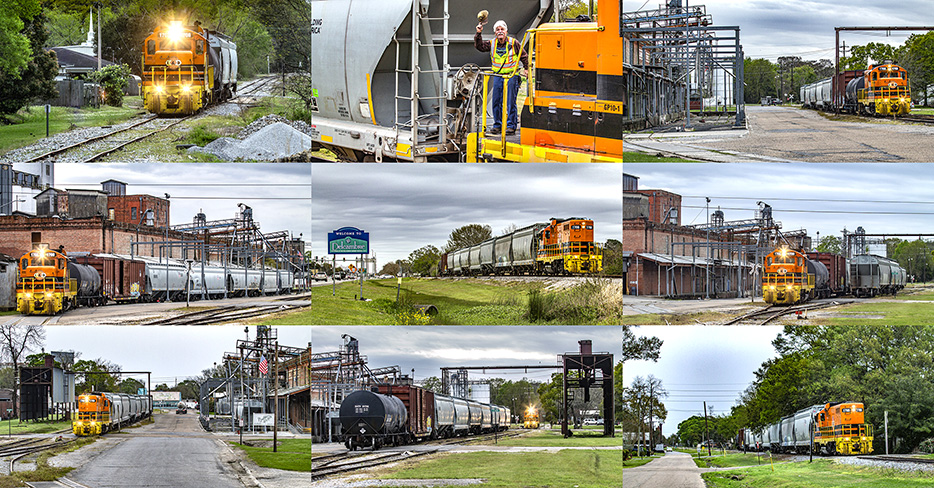
I arrive at my perch on Bob Acres Road a little way west of the Bob Acres Road crossing at 13:44 with a book to read.
So, I read the first chapter of or maybe not the first chapter of but another preface of What’s Math Got To Do With It?, and the last word any of that book when is when I was chasing the Abbeville Branch Train in December!
At some point, I must have stopped reading the book and went eastward looking for the train.
At 14:18 at Leleux Drive, I hear horns.
At 14:21 at Railroad Road, I see headlights.
We have a train!

I think that I did that shot in one of my first Abbeville Branch chases years before.
Now, here is a first. Bob Acres Road crosses the track at a very sharp angle, one of the sharpest angles of a railroad crossing that you will ever see. The optical effects of this are really neat!

How is that? There aren’t many places in which you can aim a telephoto lens down the right of way of a narrow road and get a locomotive and five cars mostly unobstructed in the image!
Here is a broadside shot probably fewer than a thousand feet to the west.
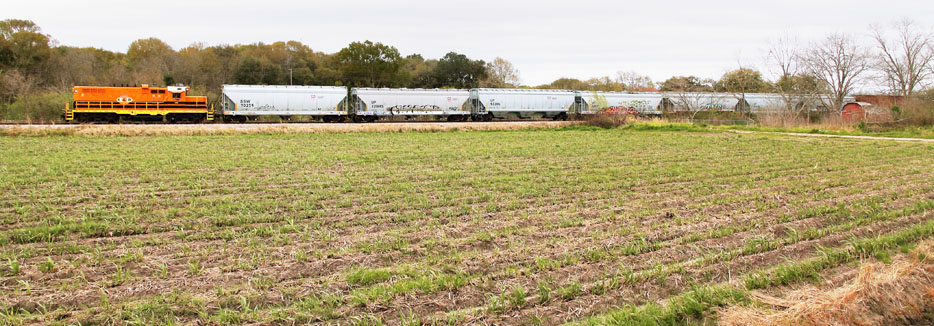
Our train today has one locomotive and nine cars; the locomotive is the LDRR 1708, seven hopper cars follow it, a Missouri Pacific Railroad boxcar followers the hopper cars, and a tank car is at the end of the train.
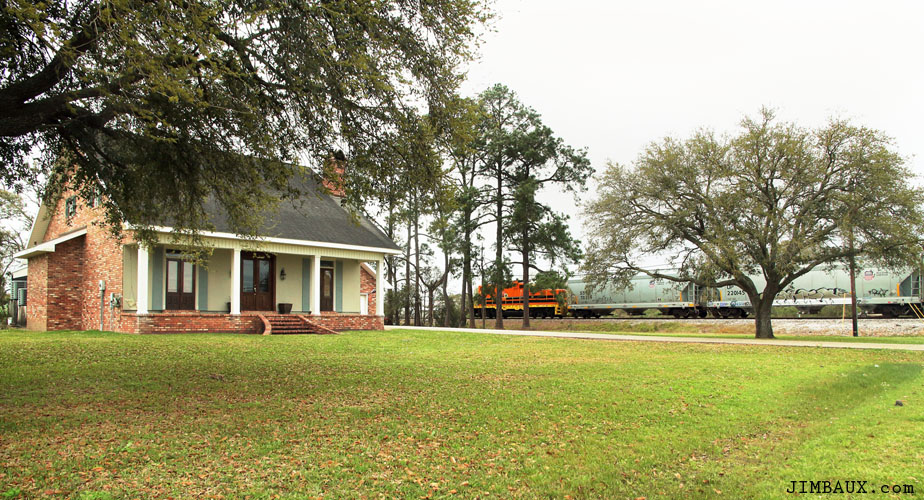
The train then had to cross the Delcambre Canal on a lift bridge, a process that is time consuming, since a trainman on the train has to open the bridge.
I had to wait a long time to get the Delcambre welcome sign shot, but I got it, the 40,000th picture with my camera, and I’m happy about that!
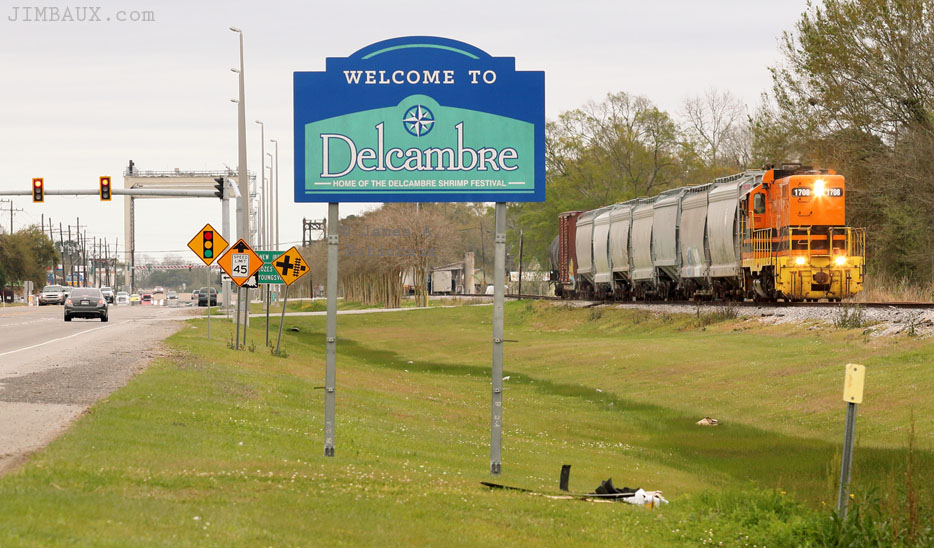
We are just a short walk from where the 30,000th picture with my camera was made!
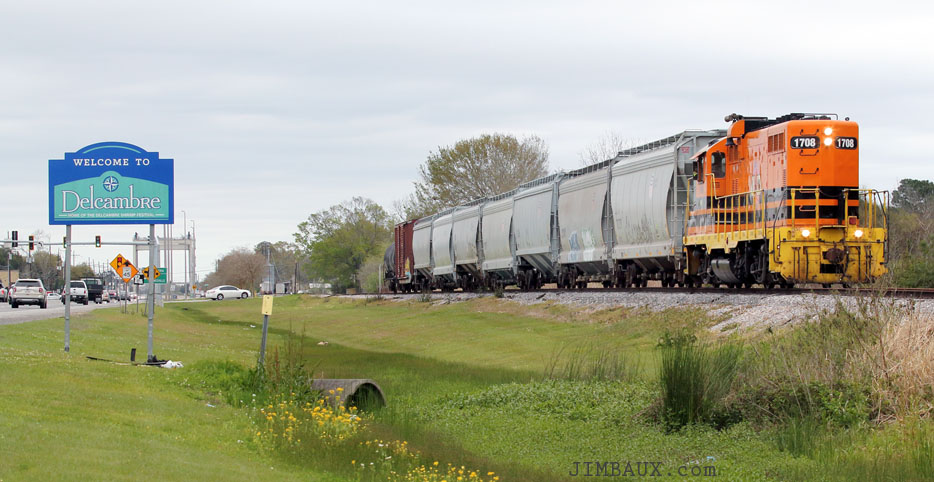
Yes, both the 30,000th image made with my camera and the 40,000th image made with my camera were made of a Louisiana & Delta Railroad train in Delcambre, Louisiana; that is both a coincidence and a testament to how activity on the Abbeville Branch has become a main subject of my photography anymore.
It’s just too bad about plenty of the people around here, though.
At 15:12, I am in Erath and just got ahead of the train into town.
I’m scoping for a good shot in Erath, but I just can’t find one special with the lighting like it is, all cloudy. I don’t like that. The post office at Municipal complex building in Erath looks interesting. I have to photograph it sometime! I guess that sometime is not today.

I am at North Kibble street.

I see KSJ’s billboard, but it ain’t in the picture.
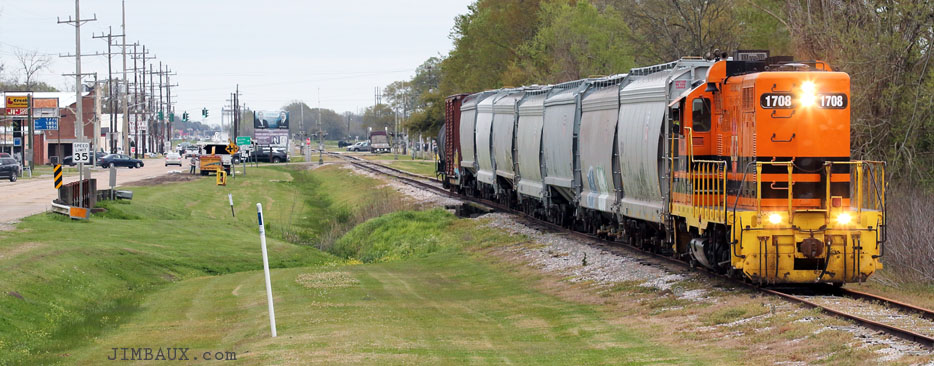
So, yeah, Peartree is in the conductor seat in the LDRR 1708.
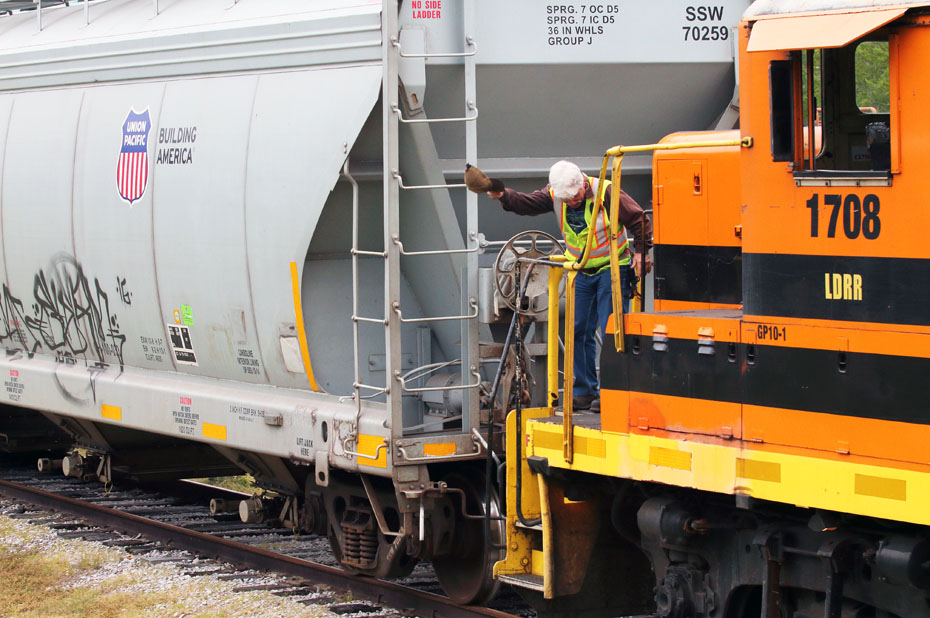
Peartree is bowing!
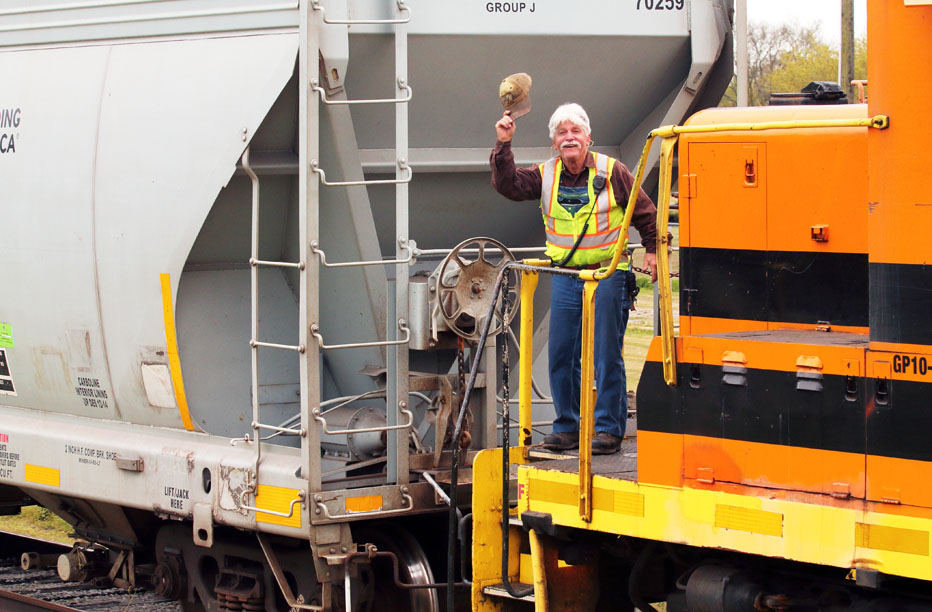
I was laughing as I photographed this!
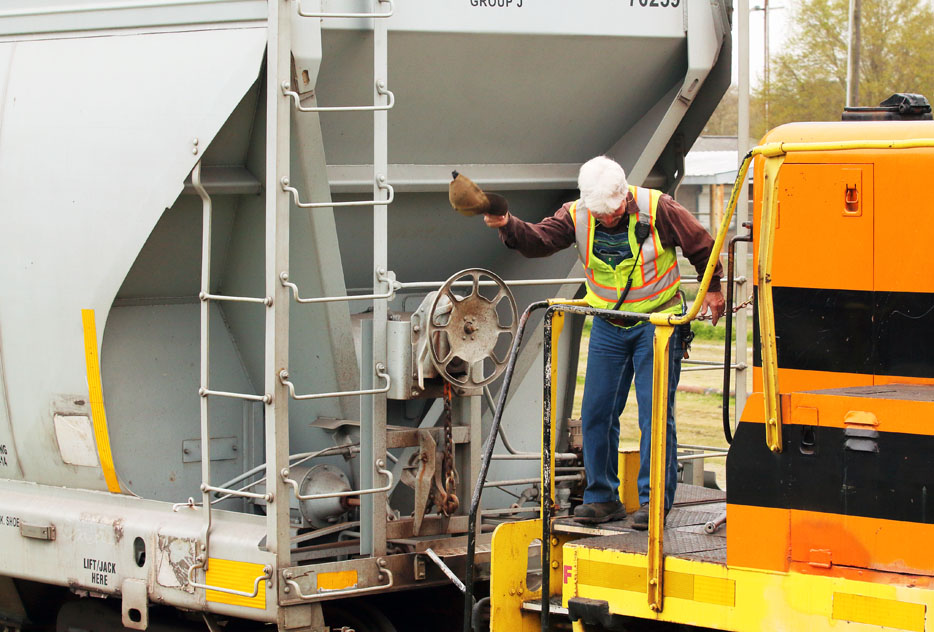
Hey, a railroader willing to show his personality to the camera, not unlike his old SP colleague Chip.
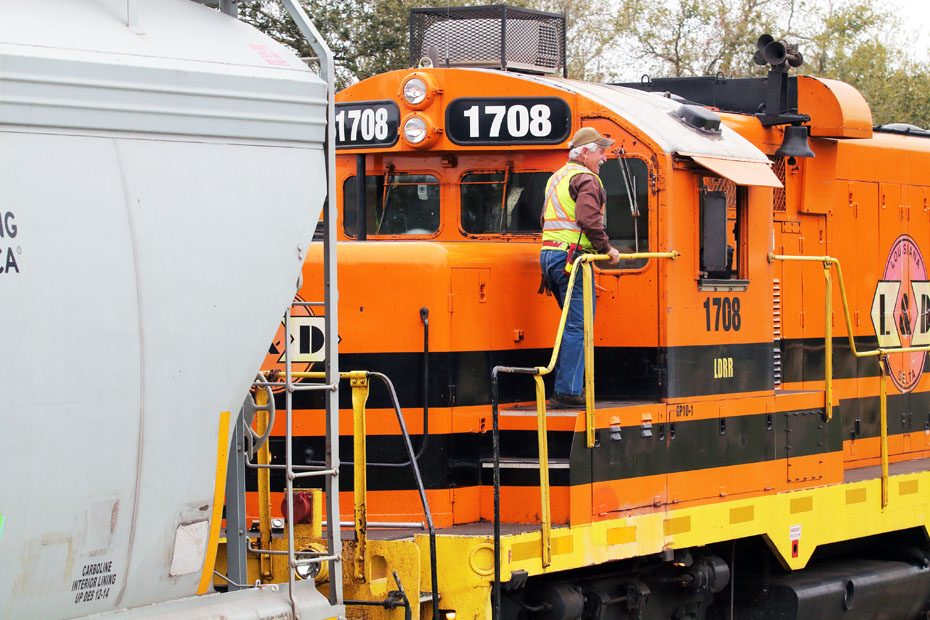
That was fun.
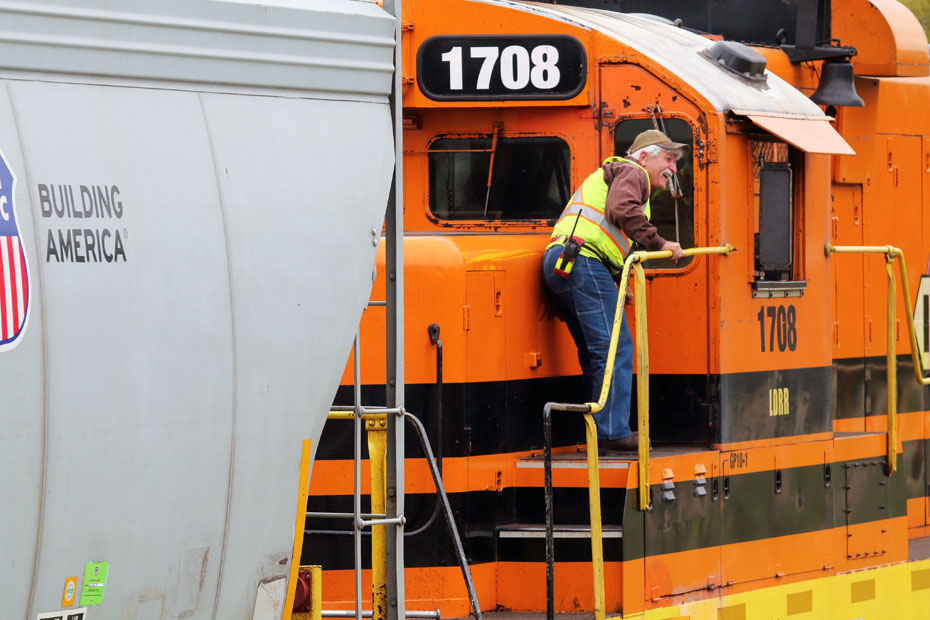
I wish that you could experience not just the images but the experience of standing there and having this train rumble past you, with the sounds and vibrations in addition to the sights.

I was able to make it to Mack just in time to get set up for that shot, which under this lighting at this particular angle doesn’t look all that great.
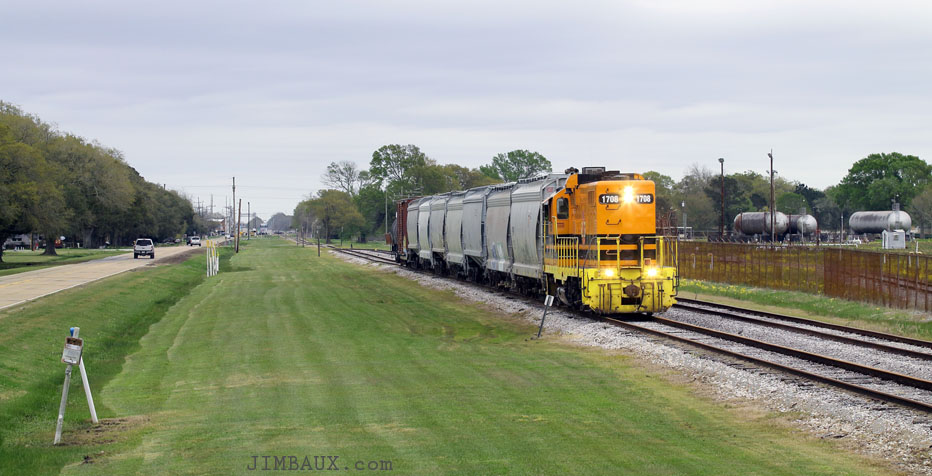
At least this allows us another view of Peartree!
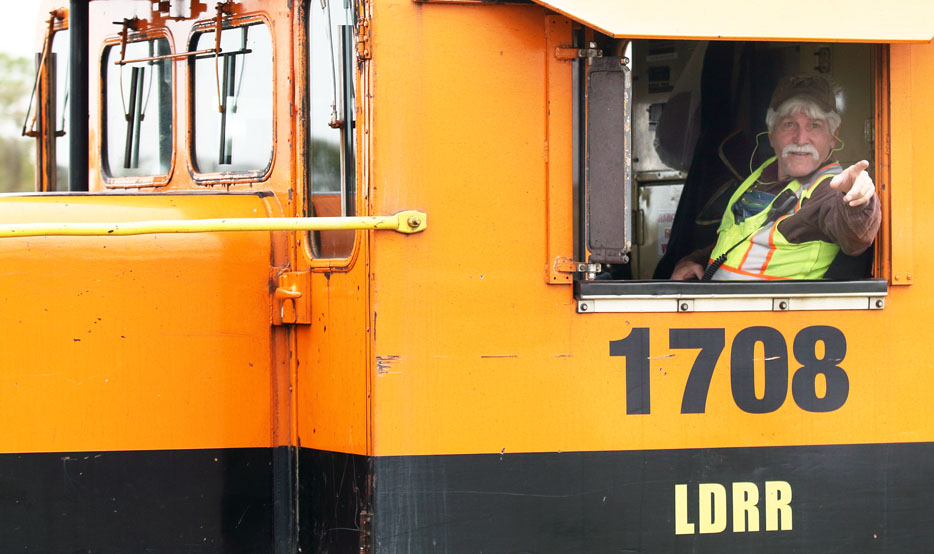
Now it is time to do the shot across Highway 14 that I like so much, though I have only enough time to get the going-away shot, which is still okay.

It is here that I imagine what trains of previous years would have looked like here, with hopper cars with railroad names on the side of them and such.
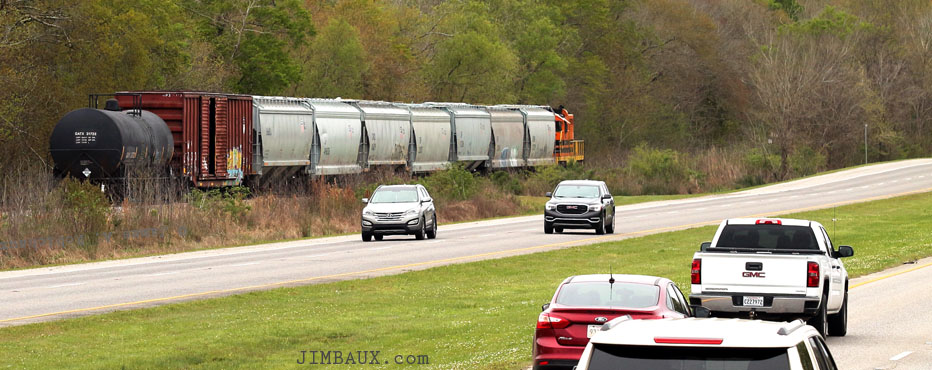
I have never done this shot by Earl’s Furniture before.
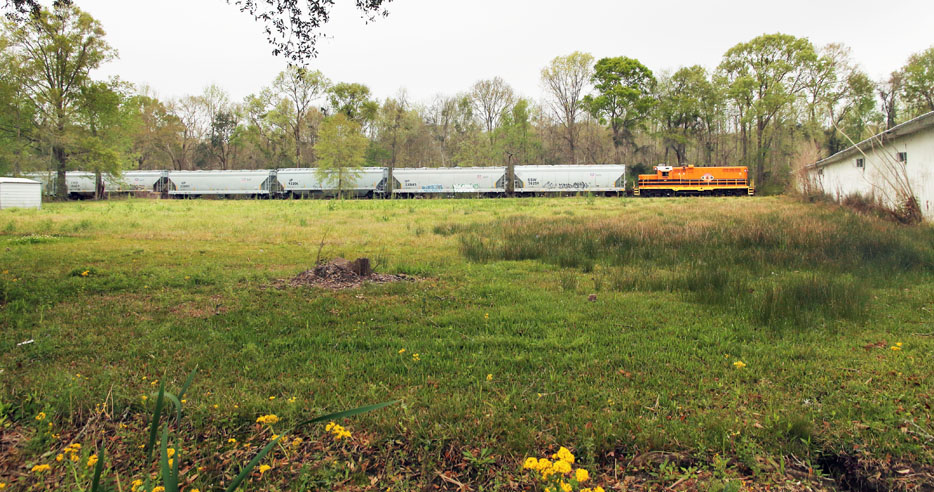
Just before 15:35, as I was just leaving a shot of the train that I did by the furniture store, I was thinking, as I was wrapping up the shots, maybe because it was a broadside shot, that I should just really watch the train, as I was photographing the cars after the locomotive passed out of sight, given that the first nearly 20 years of my life, I watched trains without photographing them. The genesis, the nexus, of my fascination with trains and railroads comes from the time before I held a camera. It was the photography of my mind.
Here we are in town now.
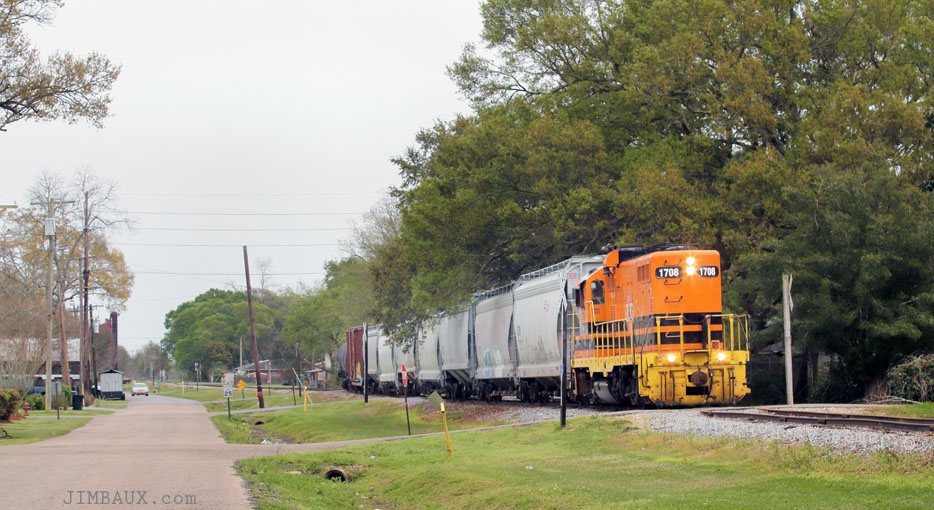
I don’t know why I didn’t do any shots between the furniture store and this shot in town, but it may be because I stopped to get some fast food, somewhere, unfortunately. I have come to think of the damage we are doing to our environment, not just directly to our bodies, with fast food.
The train arrives at the mill.
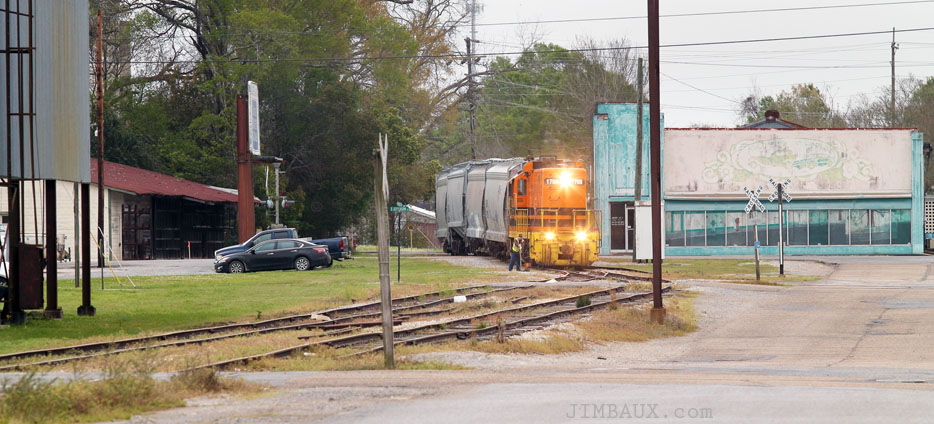
There is actually too much to photograph here, as you are about to see.
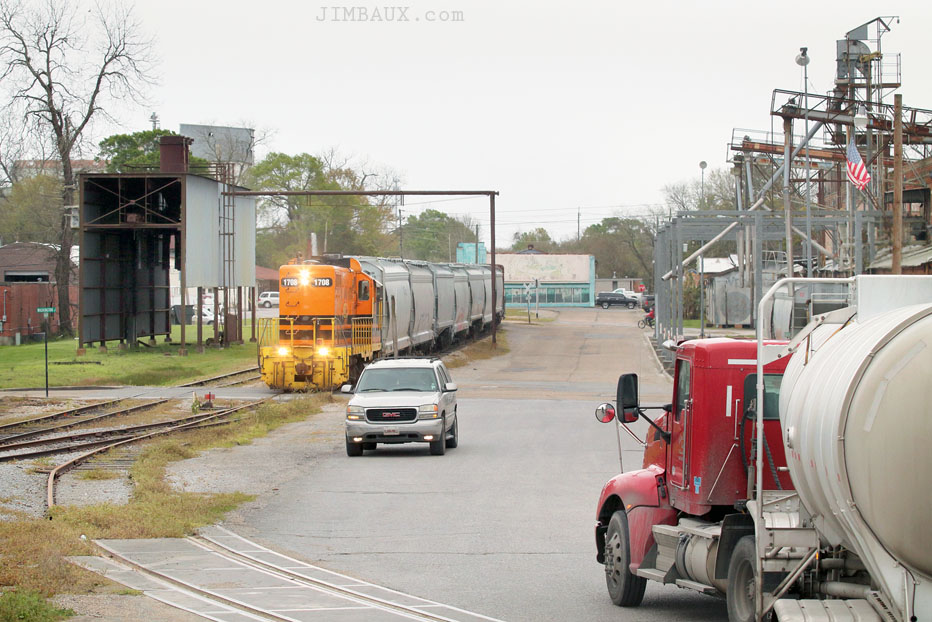
I guess that one good thing about the relatively-difficult-to-photograph nature of Valentine Paper is that I didn’t have a bunch of shots to process from the switching of the plant, and, gosh, saying all of this makes me feel old!
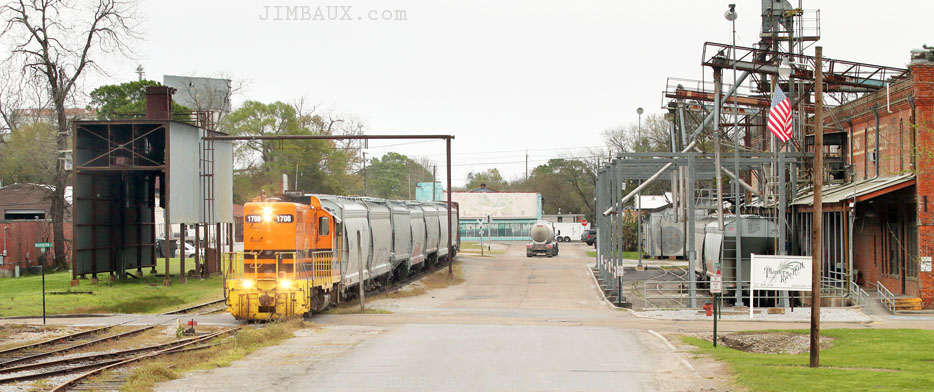
As always, the first thing that happens when the train arrives between the switches of the runaround track is the locomotive breaking off and running around the train.

In this sense, you could say that the mill is worked on the train’s return trip to New Iberia.
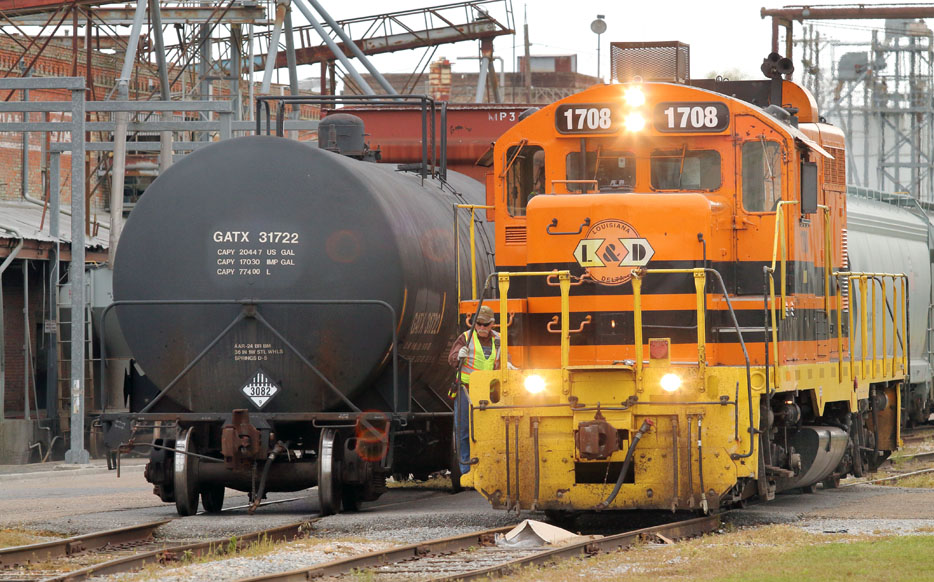
There is good ol’ Peartree again!
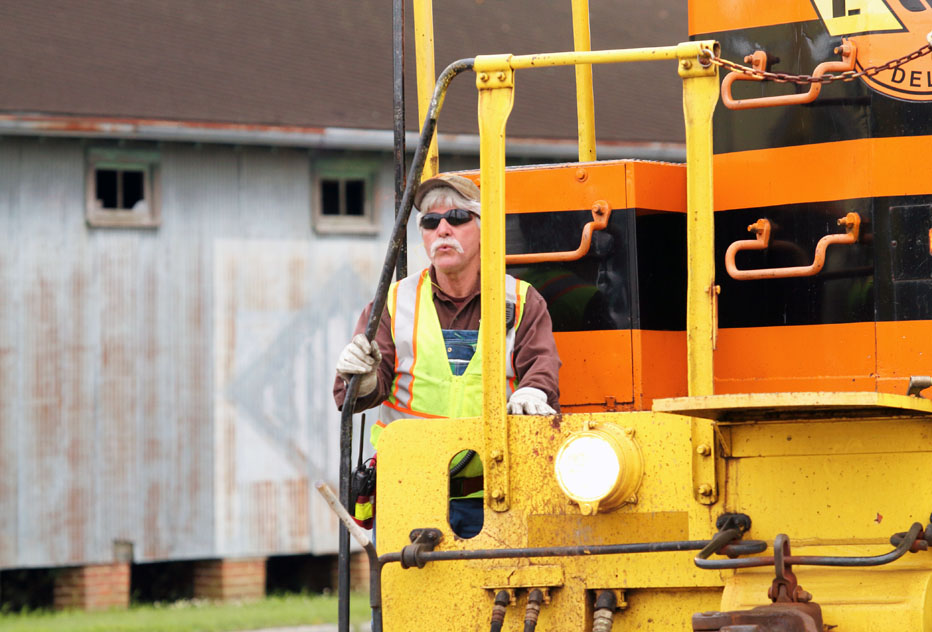
He must line the switch next to South State Street so that the locomotive can go into the mill to grab the two hopper cars that you saw in the left background in one of the above images.
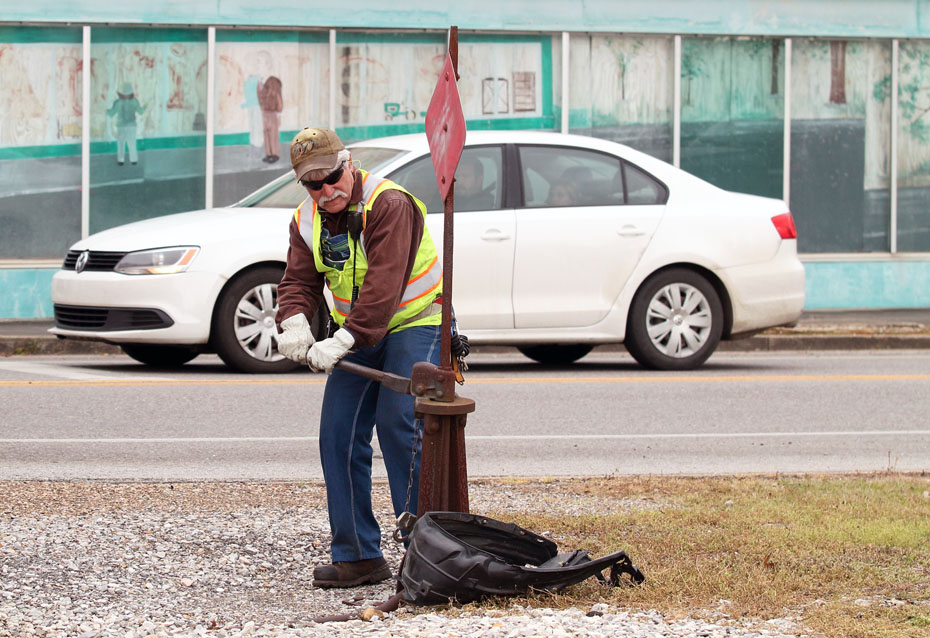
South State Street is also a state highway, and the mill switch’s proximity to it means that even just the locomotive itself must move to occupy the crossing in order to enter the mill from the west.
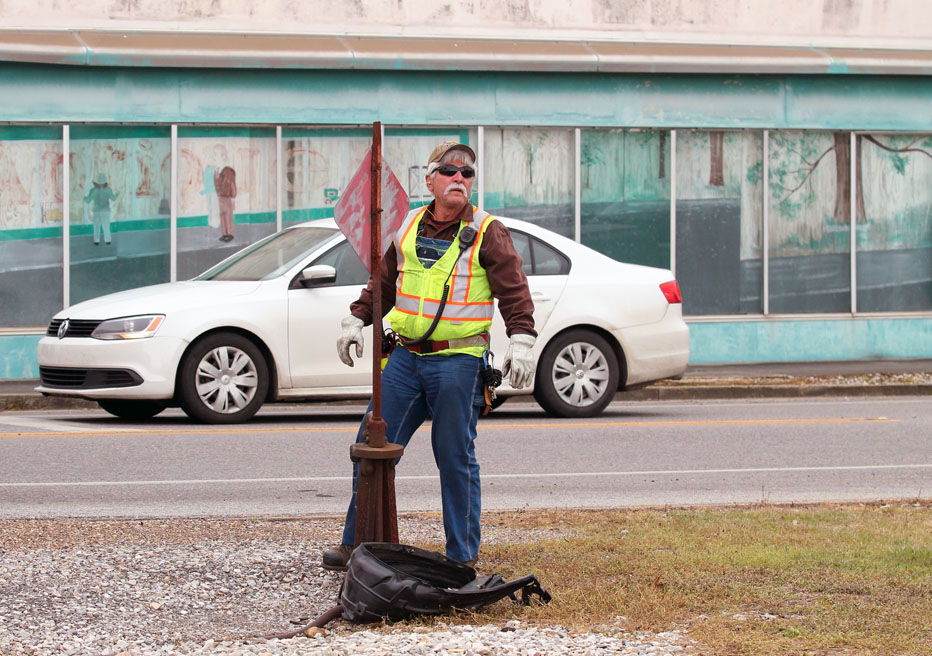
The locomotive ducks into the mill to grab the two cars.
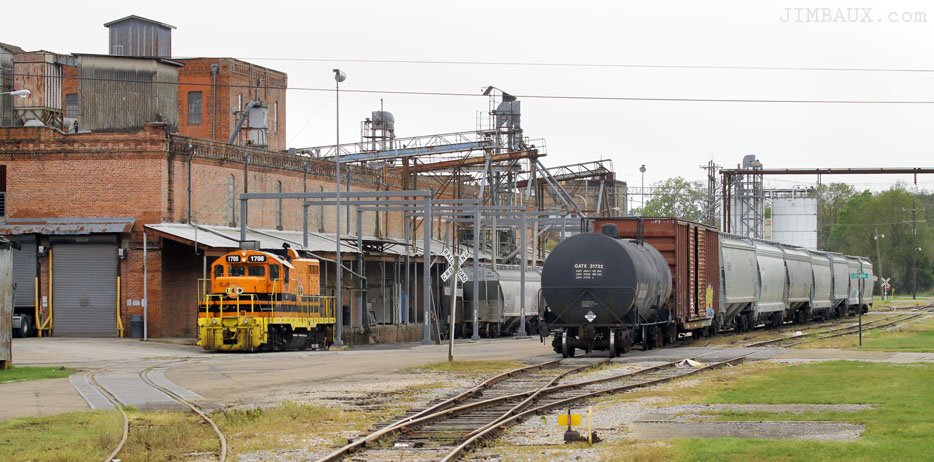
Here, you can see all of the inbound cars – that tank car is going to Coastal Chemical on the return trip – and all of the outbound cars in one view.
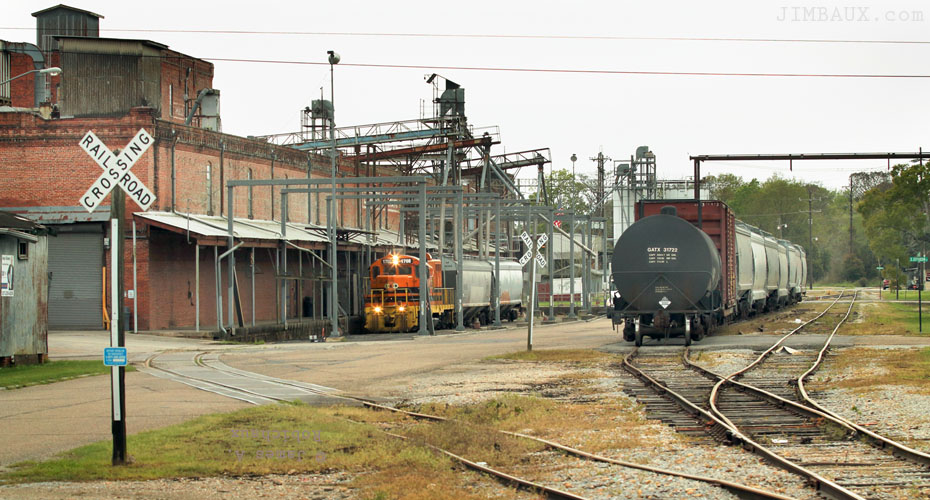
This may be the first or second time that I have seen a railroad-owned boxcar on this line!
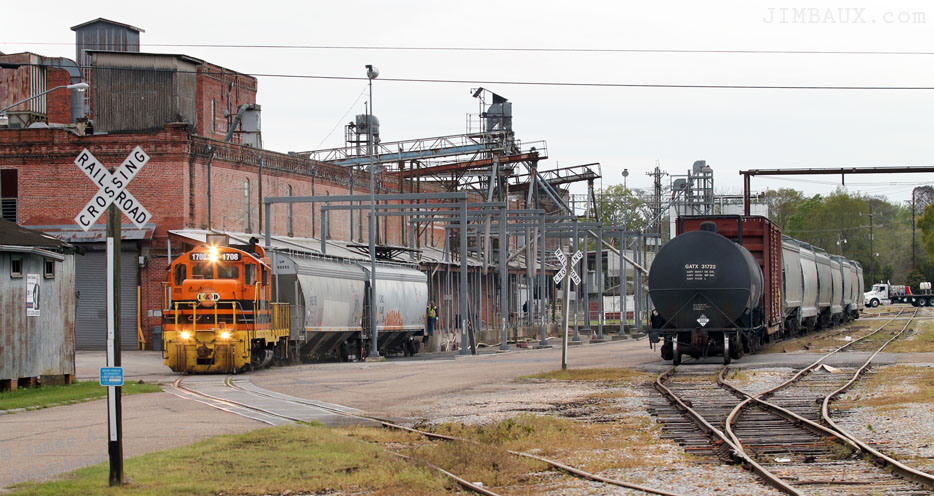
I do like this view.
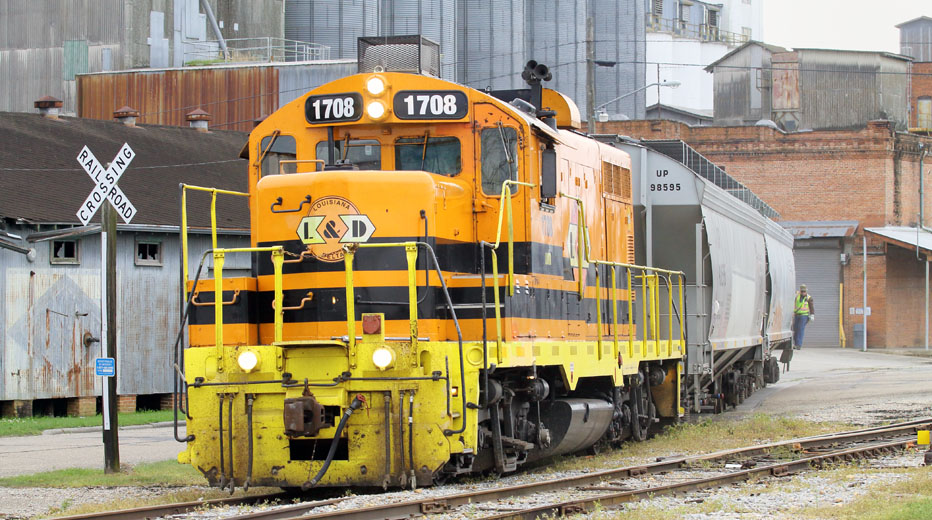
I like the old buildings here.

That building on the east side of the mill was a general store a long time ago.
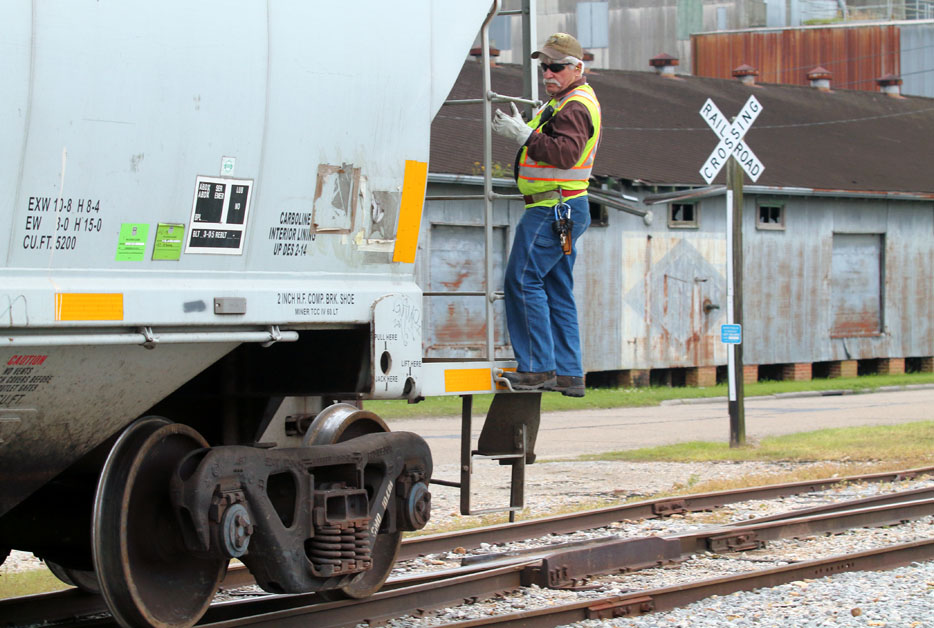
Now, with the cars clear of the switch, Peartree will line the switch so that the two cars just pulled from the mill can be shoved past the switch of the runaround track so that the inbound cars can be spotted.
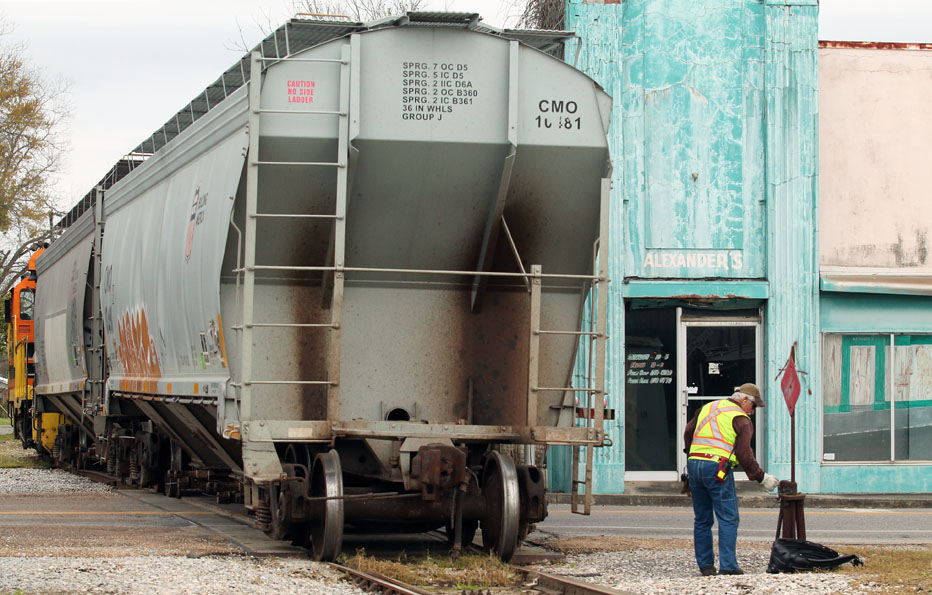
Peartree now moves to mount the CMO 10481.
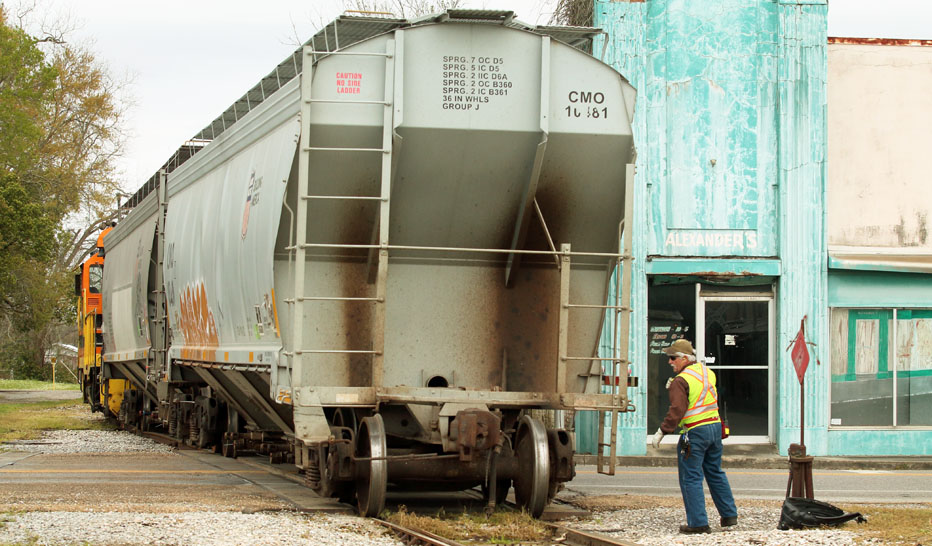
Peartree protects the shove.
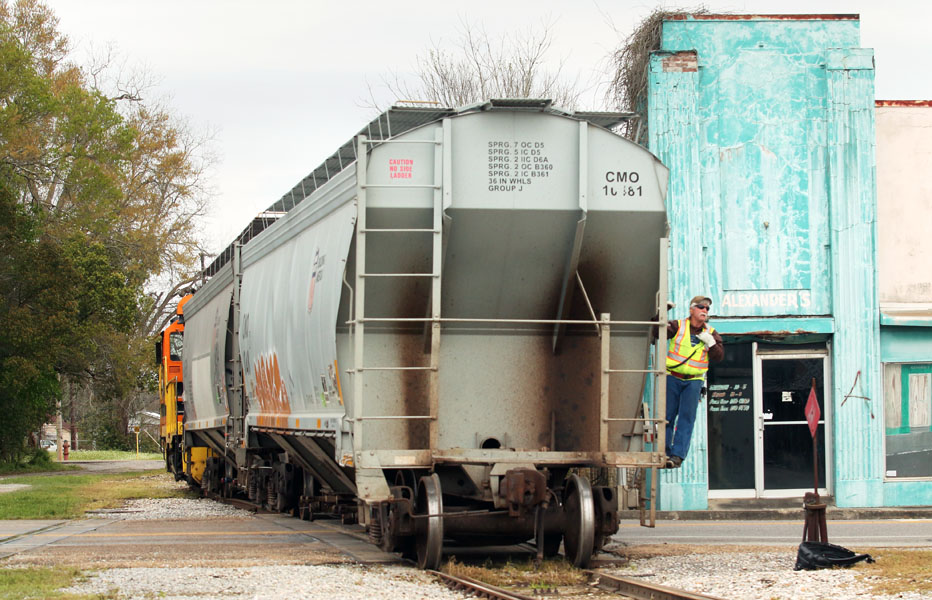
The two cars are placed on the branch mainline before the inbound cars at left are grabbed.
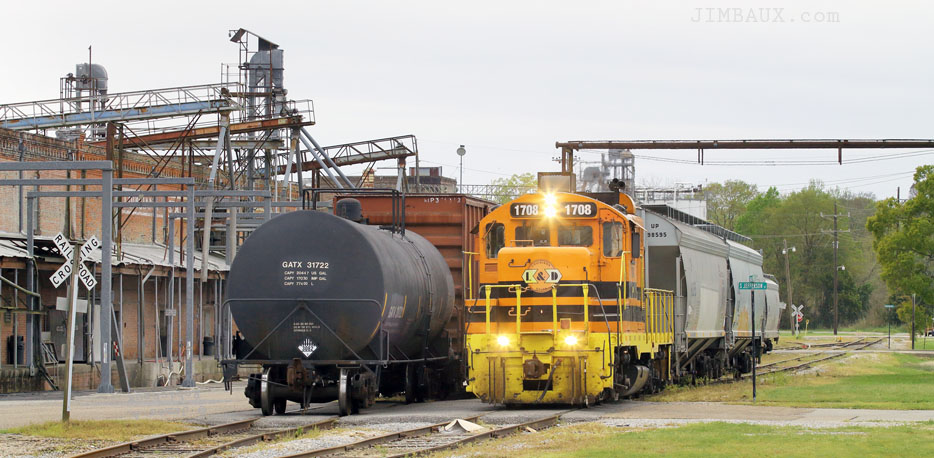
The 1708 breaks off from the two loaded hopper cars and comes past the switch for the runaround track, which Peartree then aligns for the runaround track.
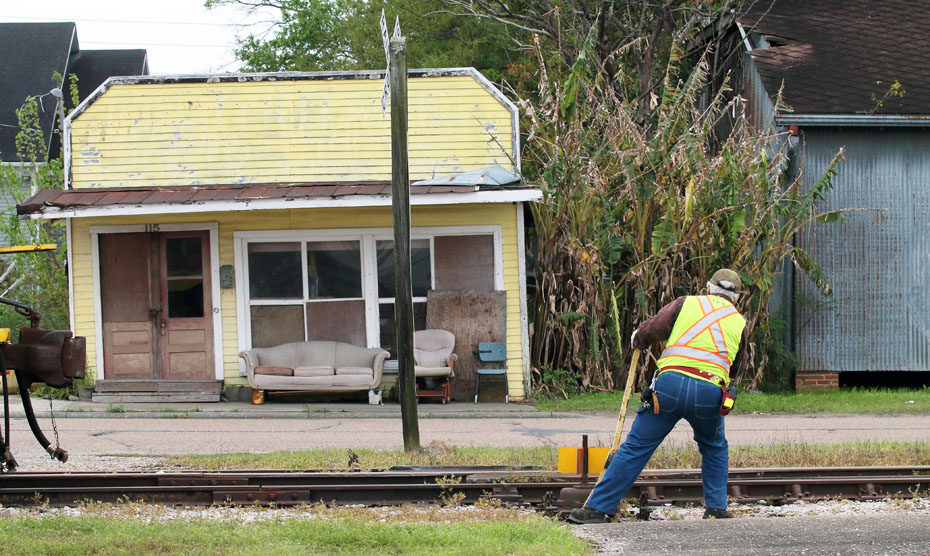
Peartree then walks and talks the 1708 to a couple with the yet-to-be-spotted cars, the still-entirety of the inbound train.
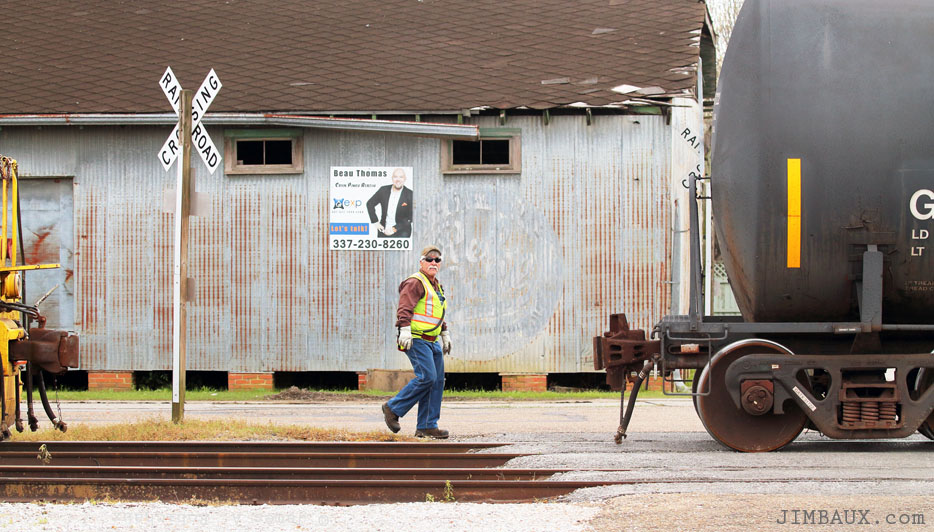
This is South Jefferson Street.

Walk and signal.
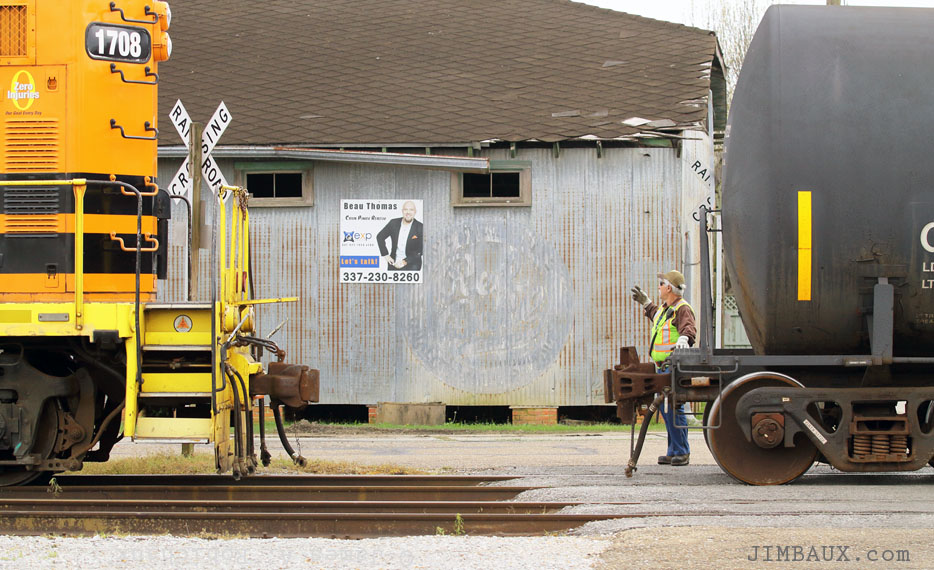
Hand signals will never not be needed, at last as long as more than one person is doing this job.
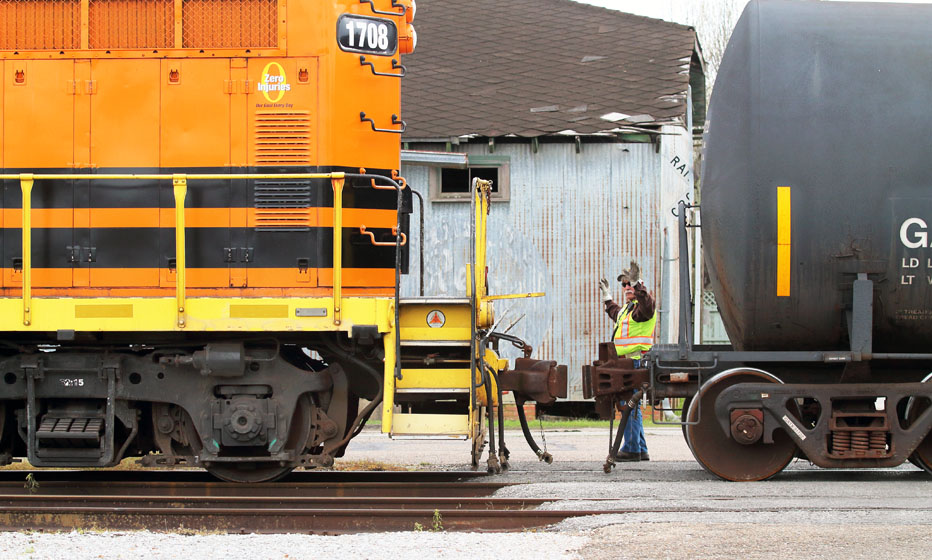
Okay, now we are coupled.
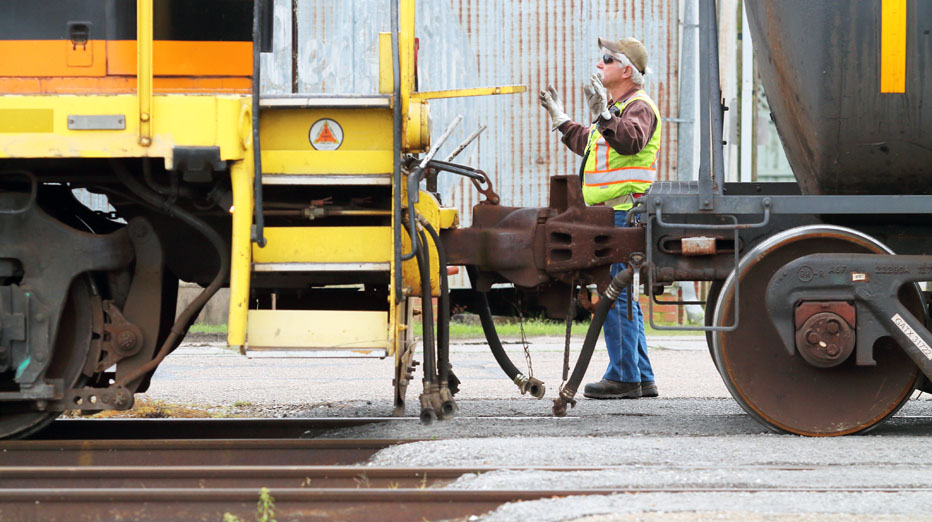
Peartree then goes “red zone” to get the air hoses connected.

The first thing to do after putting the locomotive on the other end of the nine cars that it brought into town is to shove the cut of cars into the old packaging plant next to the bayou.
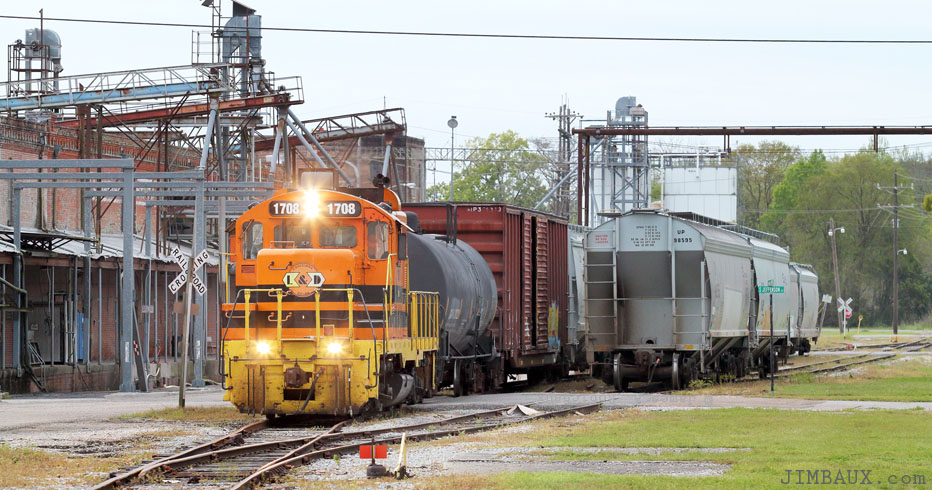
I wish that I could have seen this mill operating in its glory days, supposedly before 2005.
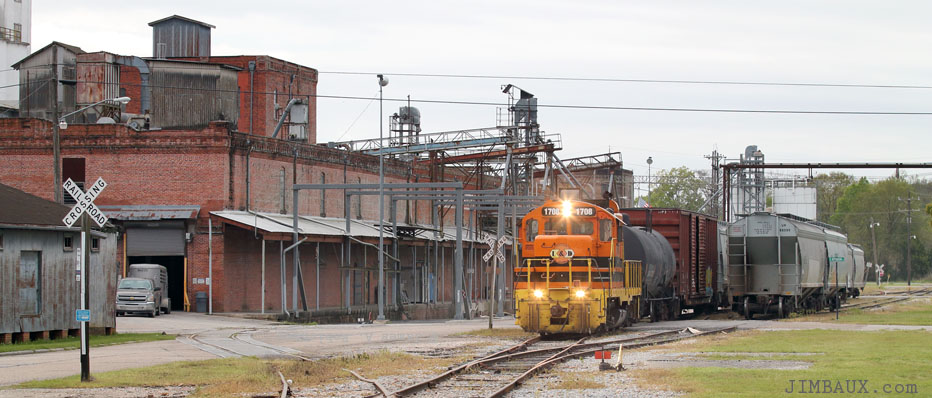
I run over to the other side of the track.
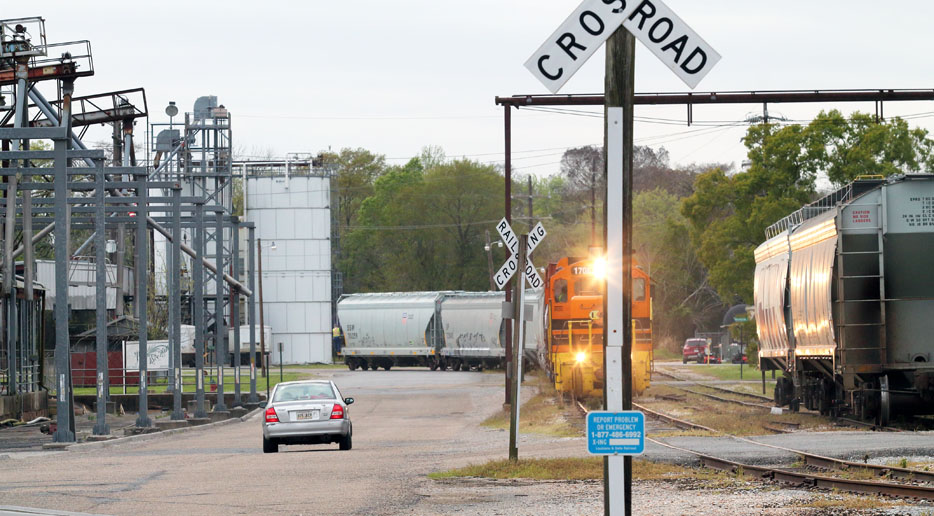
Since there are no cars in the mill proper, he can’t be shoving all of those hopper cars to the former packaging plant.
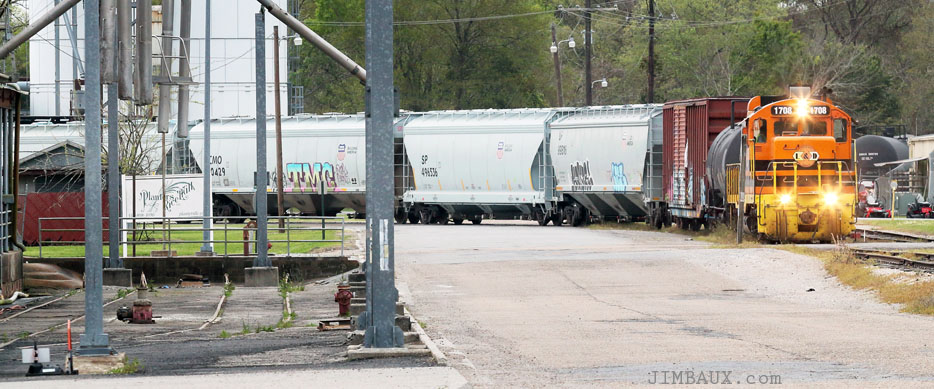
We will soon see what happens!

The livestock trailer adds a nice touch to this scene of a train switching a grain mill in a small town.
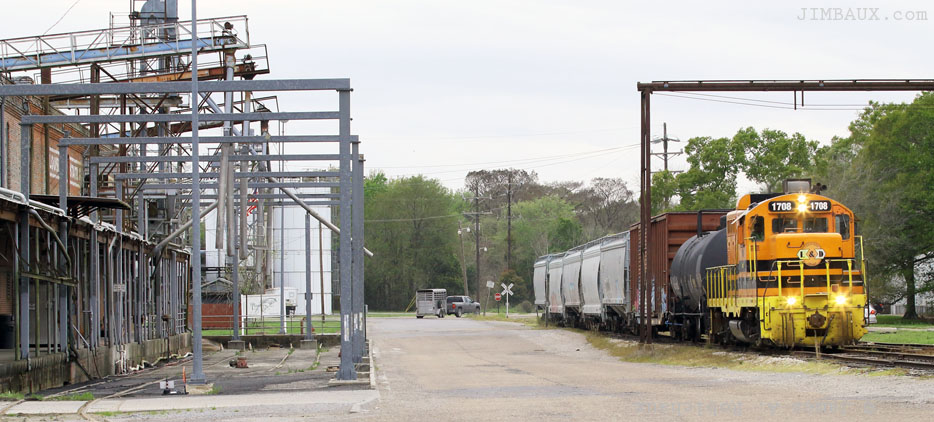
Okay, when the 1708 shoved the cut of cars there, it had seven hopper cars, and now it has five; so, two of the cars were spotted there, and now the rest of these cars – except for the tank car, which is bound for Coastal Chemical on the return trip – are going into the main mill tracks to the left.

Now, it is time for Peartree to line the switch to the mill track for the mill track after he realigns the switch on the runaround track.
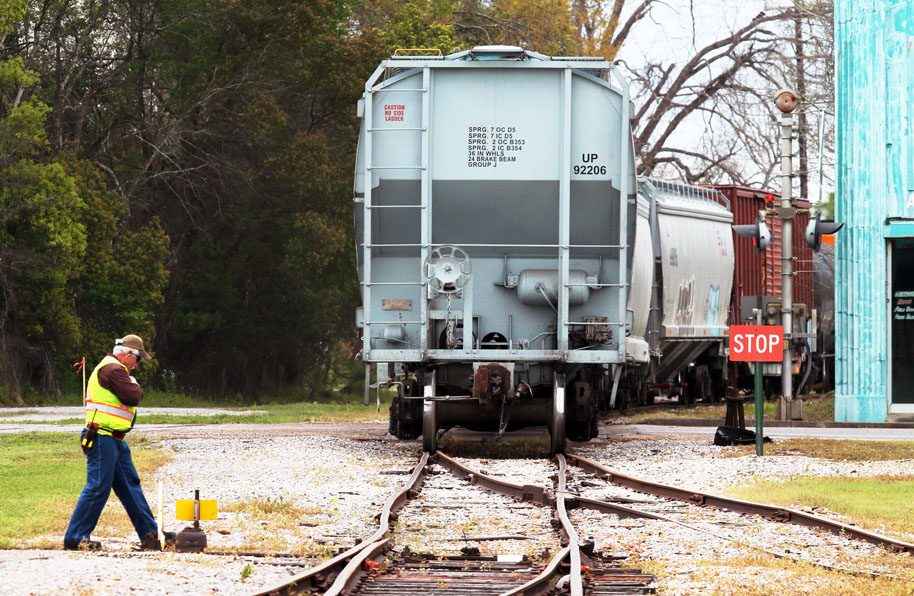
Now we’re protecting the shove to the mill!
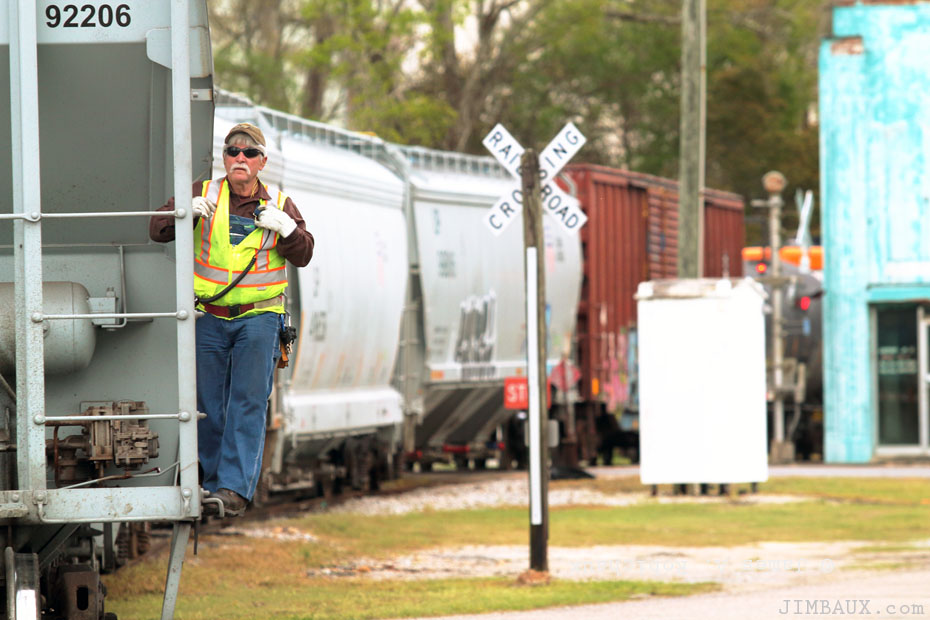
This is both classic Peartree and a classic Abbeville Branch scene.
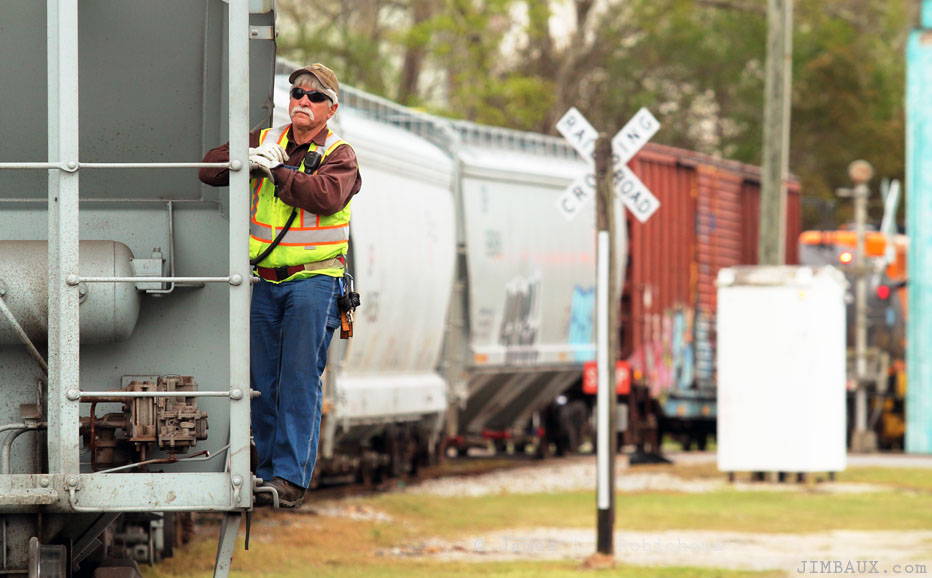
Peartree went to work for the Southern Pacific in 1973! He has seen some things, and he said that he has been hearing since 1973 that the mill was about to close.
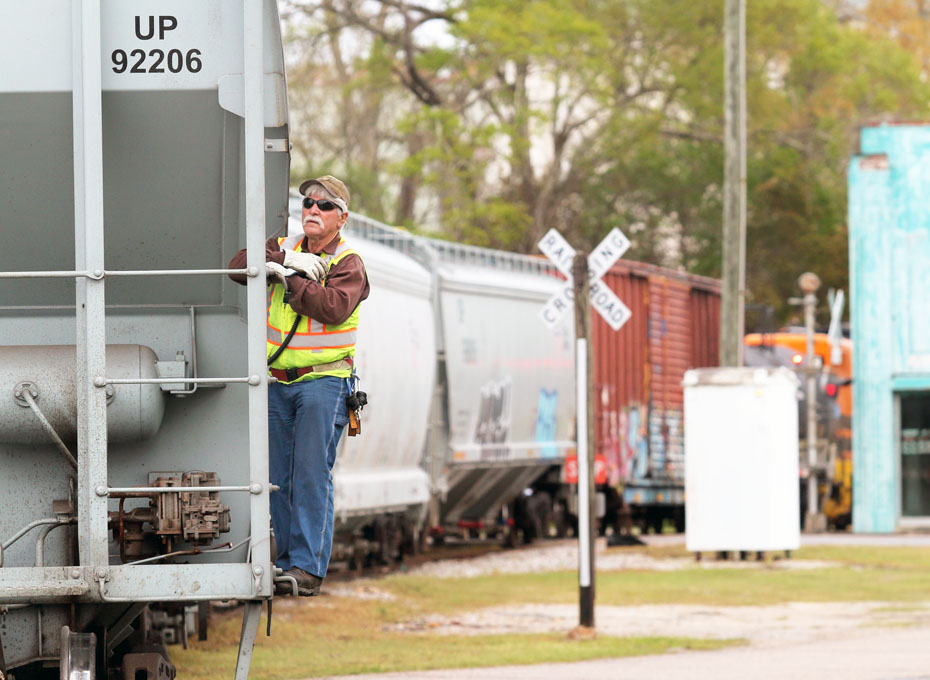
As he is crossing two streets here, he must be alert!
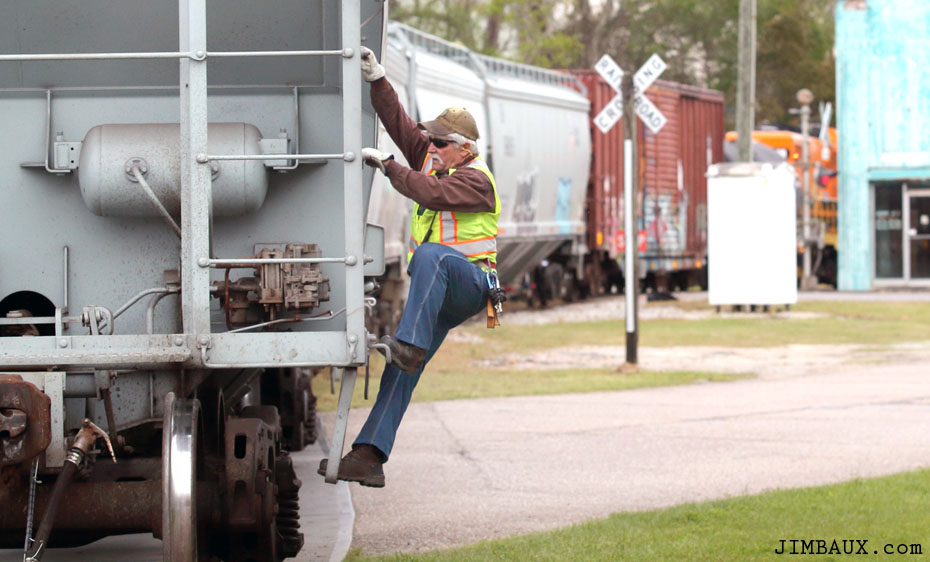
Now, Peartree dismounts to walk the cars the rest of the way.
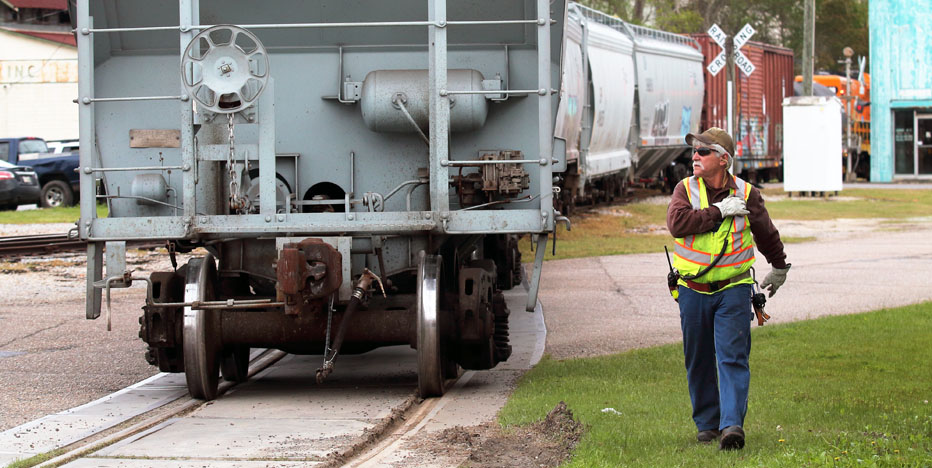
He looks northward along South Jefferson Street, checking his right.
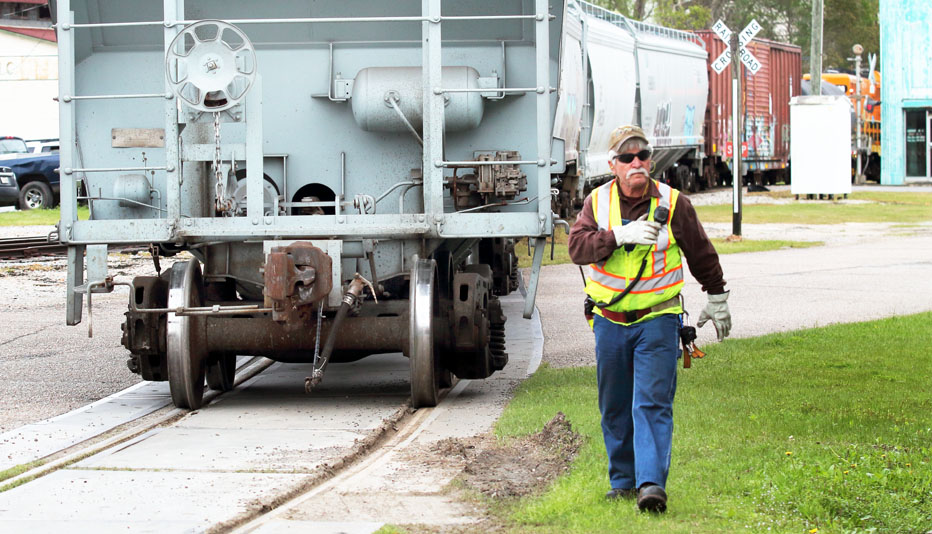
I then ran past Peartree up to past where the locomotive was and crossed the track to get the view of the cars being shoved into the mill.

I like this view.
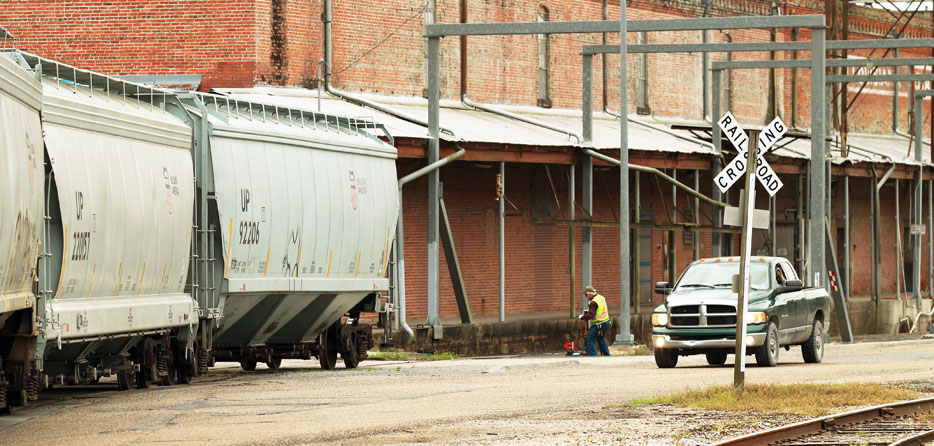
Let’s get a view that shows the cars that were pulled from the mill, too.
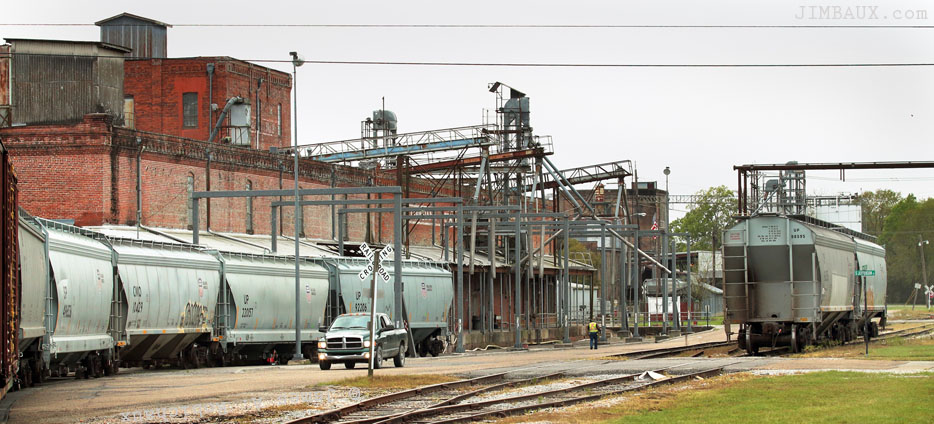
Remember that the tank car doesn’t belong at the mill and is just along for the ride until being spotted later on.
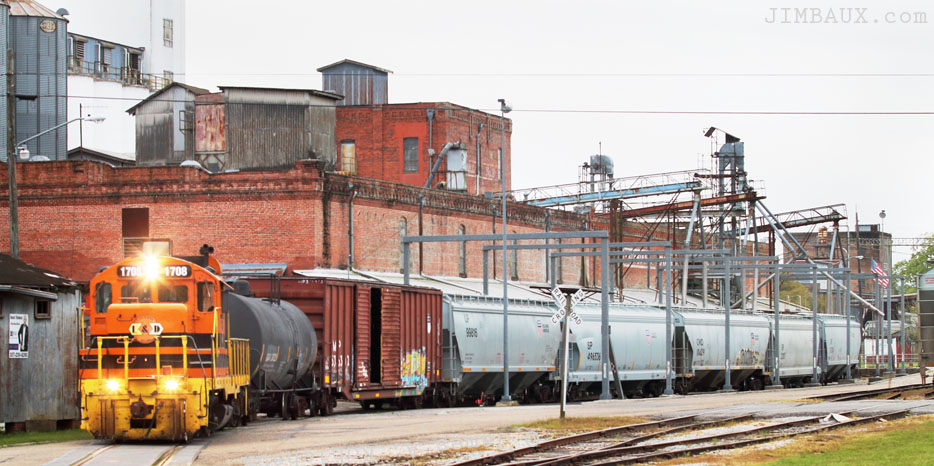
Okay, let’s get the outbound loaded hopper cars, too, in the view.

With three cars set out on the outer mill track, the 1708 pulls the tank car and what will be the last three cars spotted at the mill today forward, Peartree lines the switch for the inner track, and the 1708 shoves the remaining three cars into the inner mill track for spotting.

With that, all eight mill cars brought to town are spotted.

The 1708 and the tank car emerge from the mill; below is a cropped version of the above image.
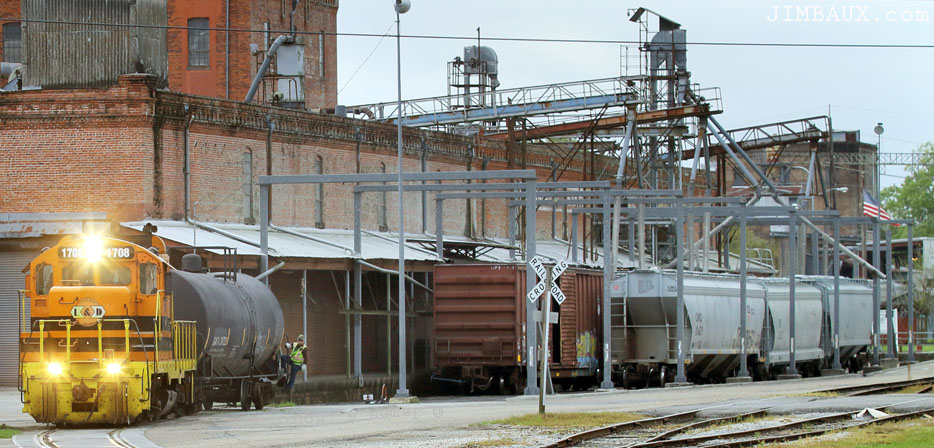
And below is a further cropped version of still the same image! Do you see Peartree hanging off of the tank car?
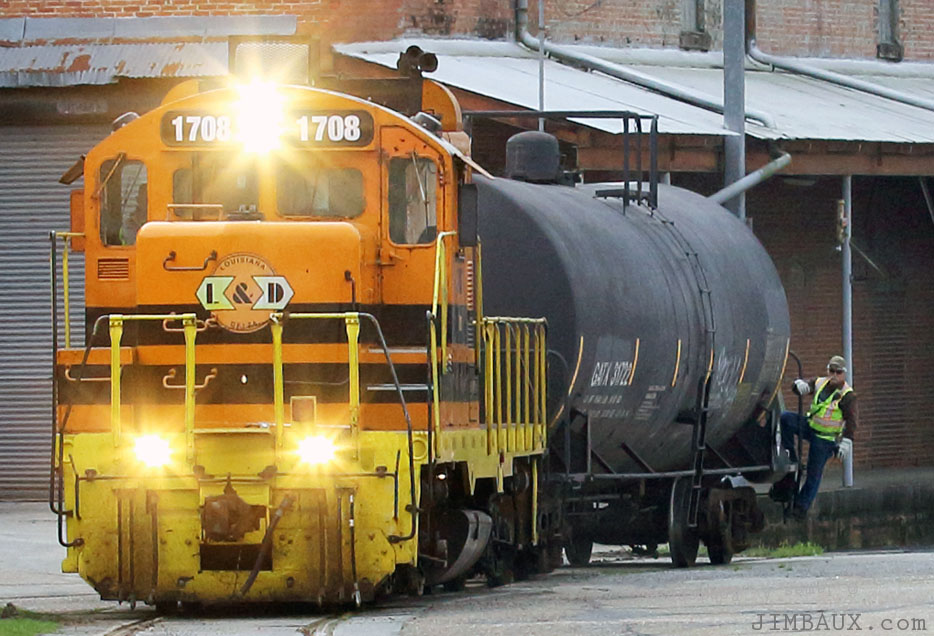
That is that.
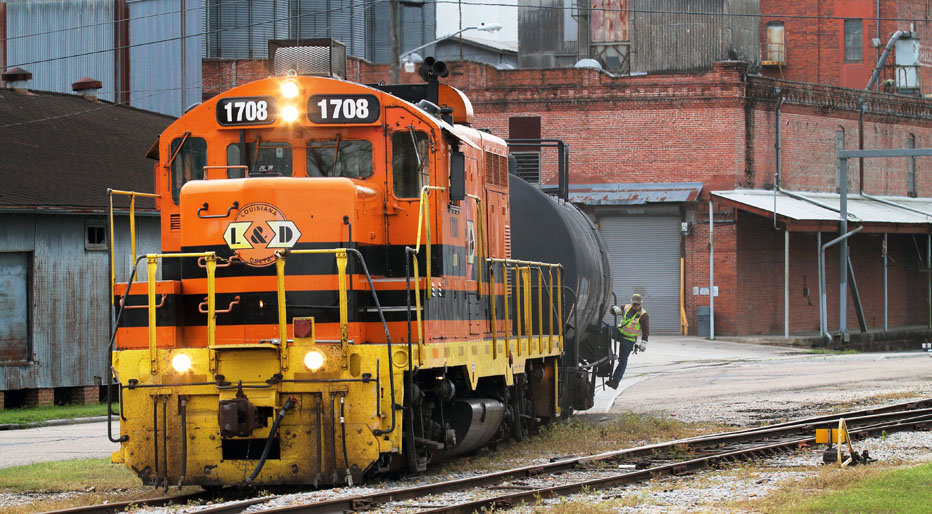
All that remains of the view, as we look eastward up the branch mainline, is to shove to couple onto the two loaded hopper cars and leave.
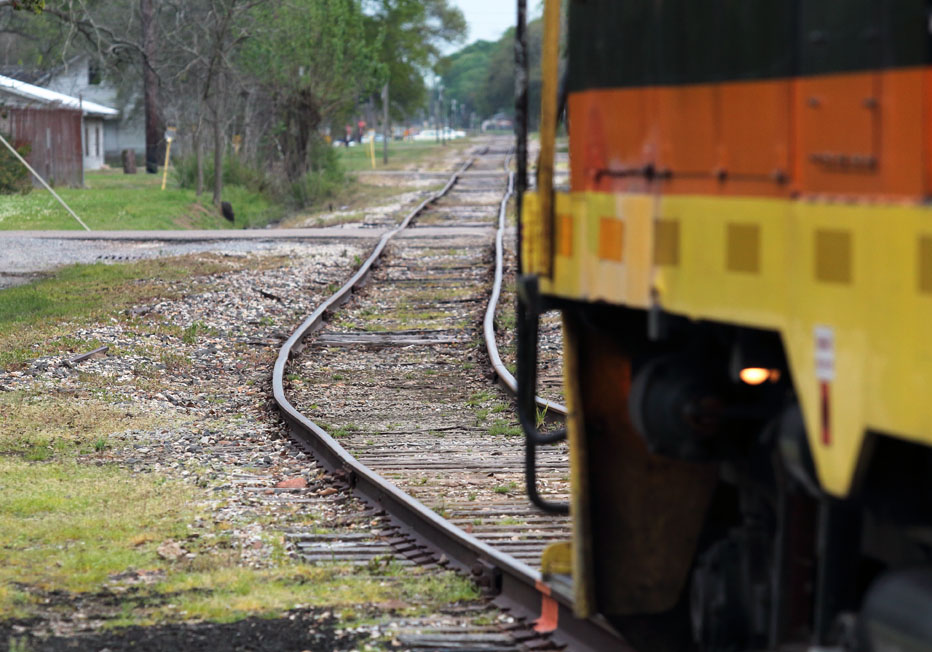
The locomotive and the tank car backing up to the two loaded hopper cars means that our outbound train is built.
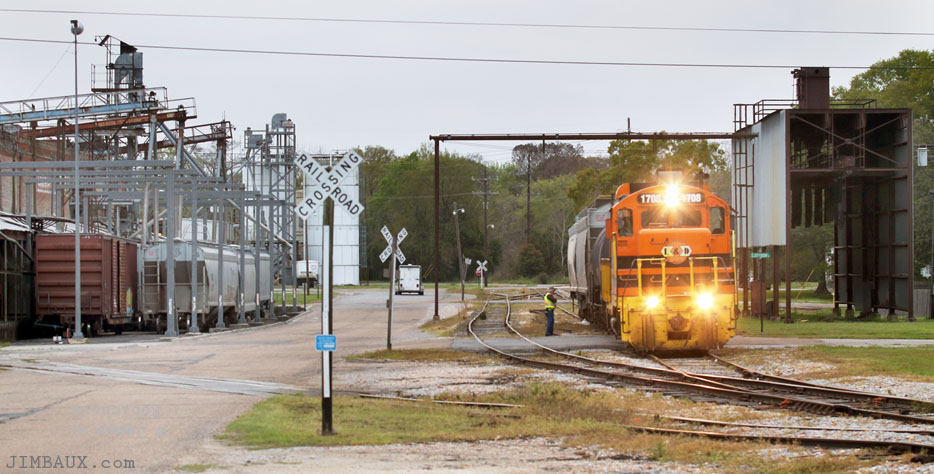
I like that view, especially as it shows both the just-delivered cars at left and the old hull loader at right.
I got set up at S. John M. Hardy Road.

I like the view of the very branchlineish track here.
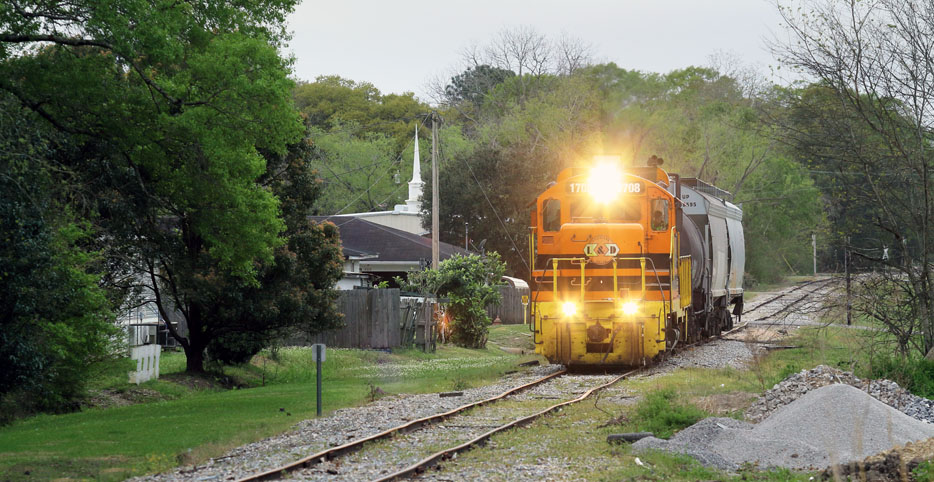
I like that old gravel tipple, and I guess that there was once railroad service to this facility.
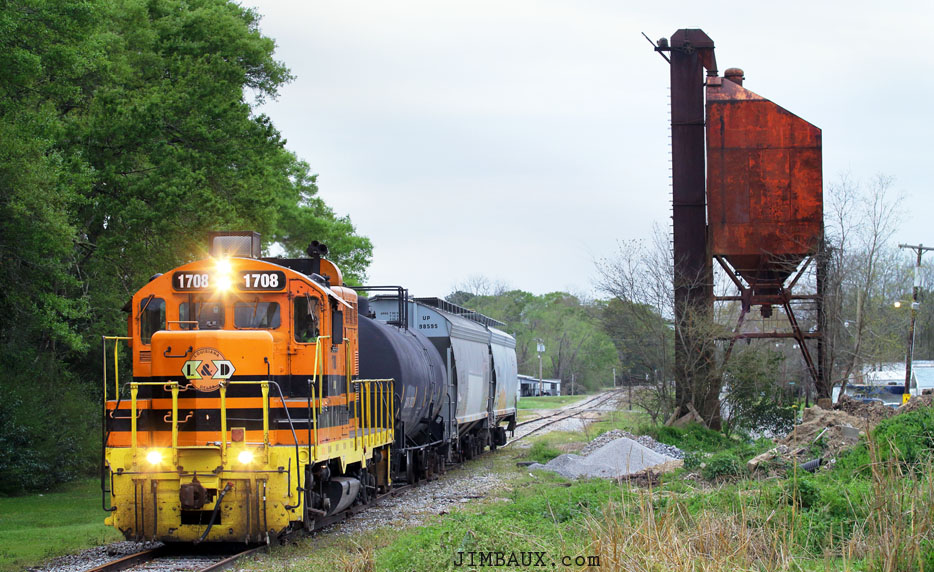
I think that that is my shot of the day!
Next, I am at Airport Road.
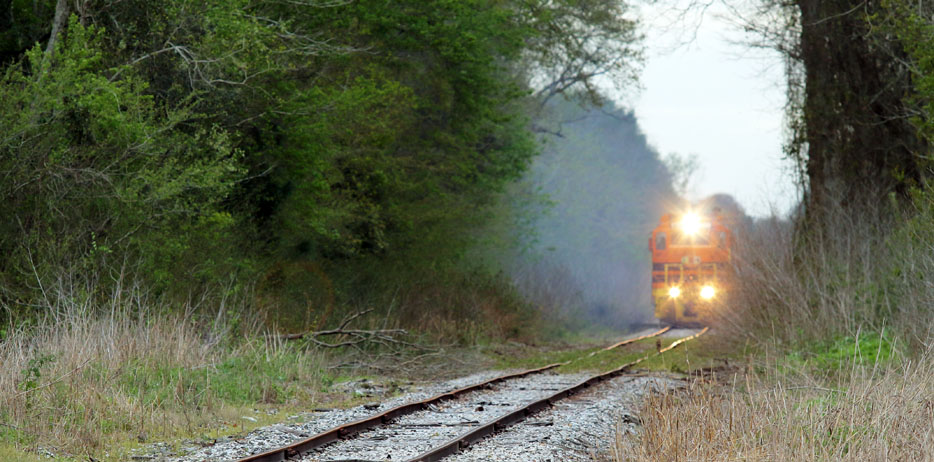
This shot is a bit too head-on for my liking, but I do like the tree-canopy effect here.
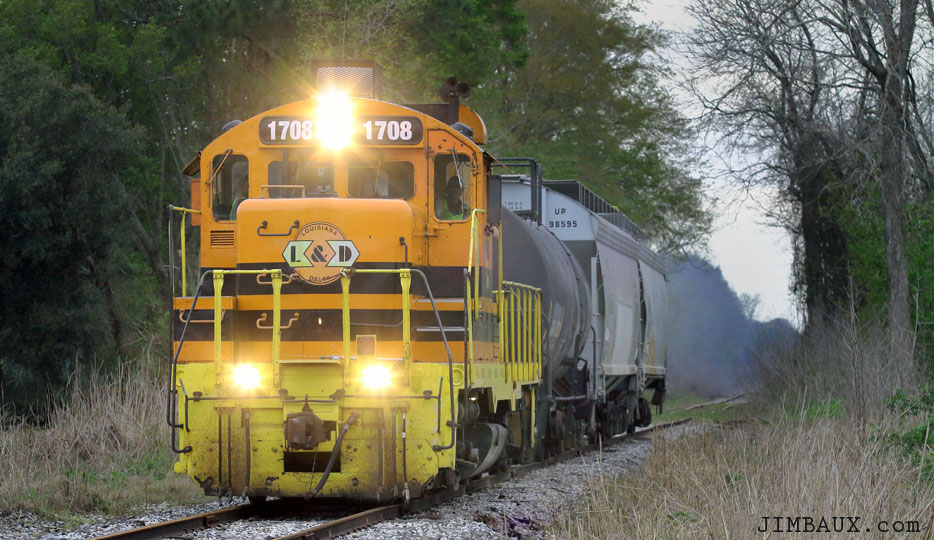
Next, the train would stop in a few hundred feet to set out that tank car.
The time is 17:27, and I’m sitting at the beginning of Business 14 on the west side of Erath, and I have a little bit of time to wait as the train has stopped to work Coastal Chemical.

I was thinking earlier about how I should mention here of the thought that popped into my head on Tuesday morning as I was aout for a walk.
I thought about how, if a full carbon tax had been implemented prior to the Staggers ACT in 1980, I wonder how branchlines and boxcars and such would look different today. So many of the things that I and so many other railroad enthusiasts like about the railroads of decades ago, like branchlines, railroad-owned cars, boxcars, and customers shipping or receiving small quantities of cars, might still be here in more abundance had a full carbon tax been implemented 40 years ago when it was proposed, not to mention how we might not be facing an apocalypse!
It probably wouldn’t have saved the Supreme Branch or the Lockport Branch, but I imagine that the Houma Branch might still be there, and I imagine that Masonry Products, now at the end of the Bernadotte Line, would be getting much more of its bricks by truck.
Anyway, with the work at Coastal Chemical done, here comes our train.

I really like this view of the train as a strong background element of a scene of highway traffic.
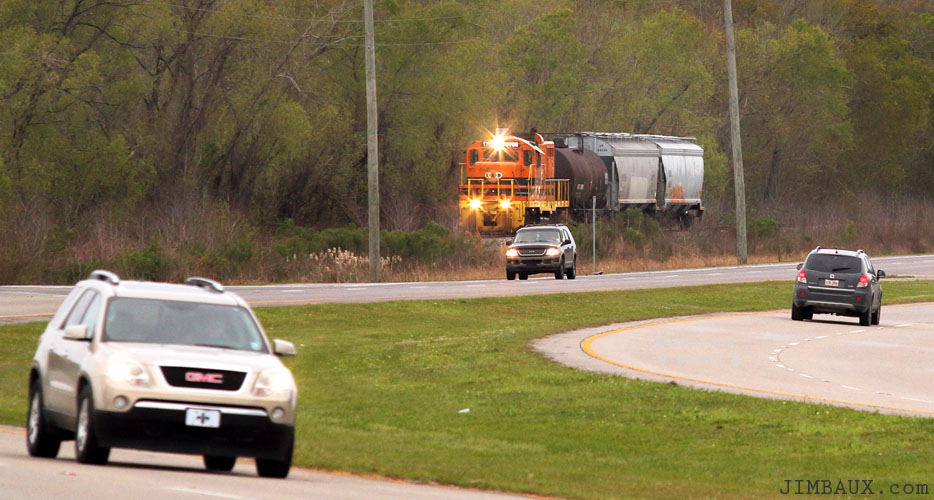
So, please keep in mind that the tank car that you see now isn’t the same tank car that you saw in all scenes prior to this view over Highway 14.
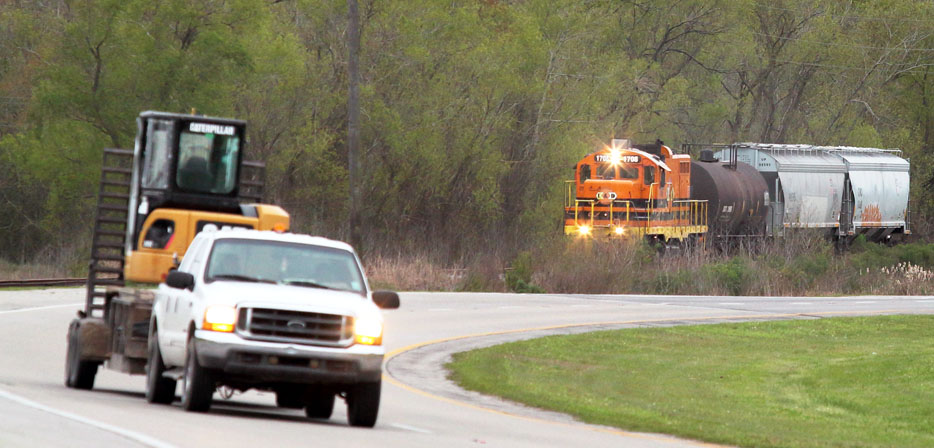
The 1708 grabbed an empty tank car from Coastal Chemical when it stopped to spot the one that it brought to town.

I like this view, and I think that I will do it again in the future!

Now, as the train moves along, we don’t see the highway anymore, even though the old highway was in the goreground of this image.

You can see what I mean by looking at the satellite view of this location.
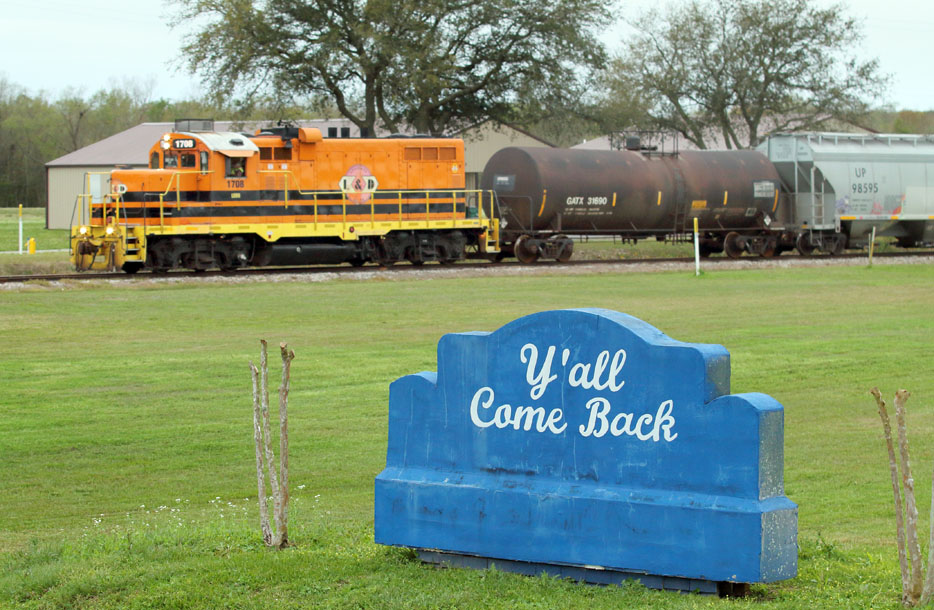
I will come back.
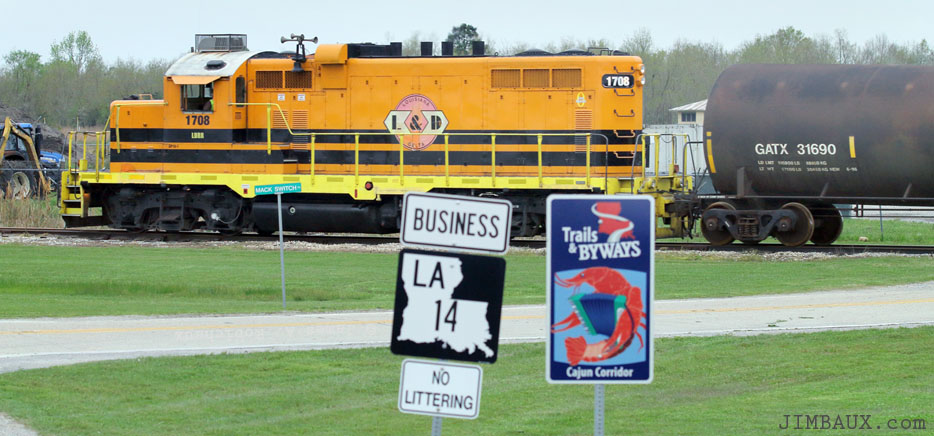
It’s getting dark, I am getting tired, and I have taken way too many pictures. So, I will make one last stand by the ball park in Erath and call it a day.

You can tell how dark it is, which is to say that you can tell how hard the photography and photo-editing equipment and software are compensating, but the blobby nature of the headlights of both the train and the automobiles.

I guess that that is a good way to end it.
Thanks for reading all of this and for looking at the numerous pictures!
Peace.
Jbx

You must log in to post a comment.